When we were buying our round-the-world tickets, the Zip World agency suggested adding Easter Island to our itinerary for 10 euros more per person! At that moment, we looked at each other like kids who had just received an unexpected gift. We could already see ourselves sleeping amidst the moai on one of the world’s most isolated and mysterious islands! In the end, we stayed there for 5 days as an introduction to South America after Indonesia and a 4-day stay in Sydney. To help you with your preparations, here is our practical travel guide to visiting Easter Island along with a supplementary article on the budget. Something tells me you’re going to love your next trip ;).
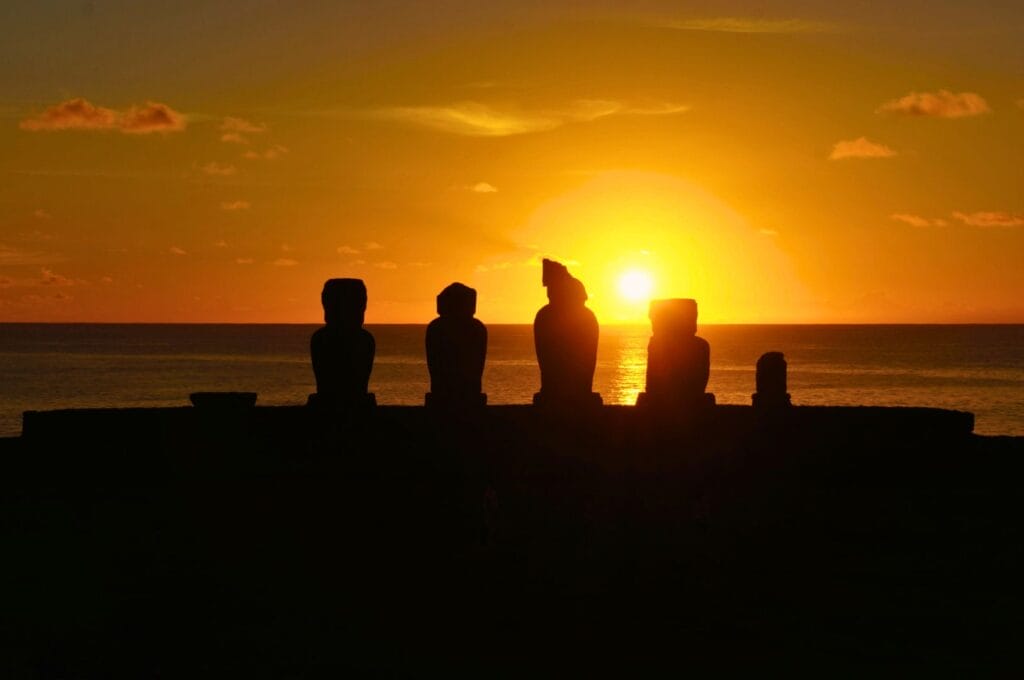
- Introduction to Easter Island
- A closer look at the Moai on Rapa Nui
- What’s the best time to visit Easter Island?
- How to get to Easter Island
- Administrative steps before traveling to Easter Island
- Accommodation on Easter Island
- Electricity and internet access on Rapa Nui
- Hiring a guide to visit Easter Island
- How to get around Rapa Nui
- Things to do on Easter Island
- Our opinion on this trip to Rapa Nui
We took this trip in 2014, but the article was completely revised and updated in August 2024. If you see any price changes or have additional information that might be relevant, please feel free to leave us a comment!
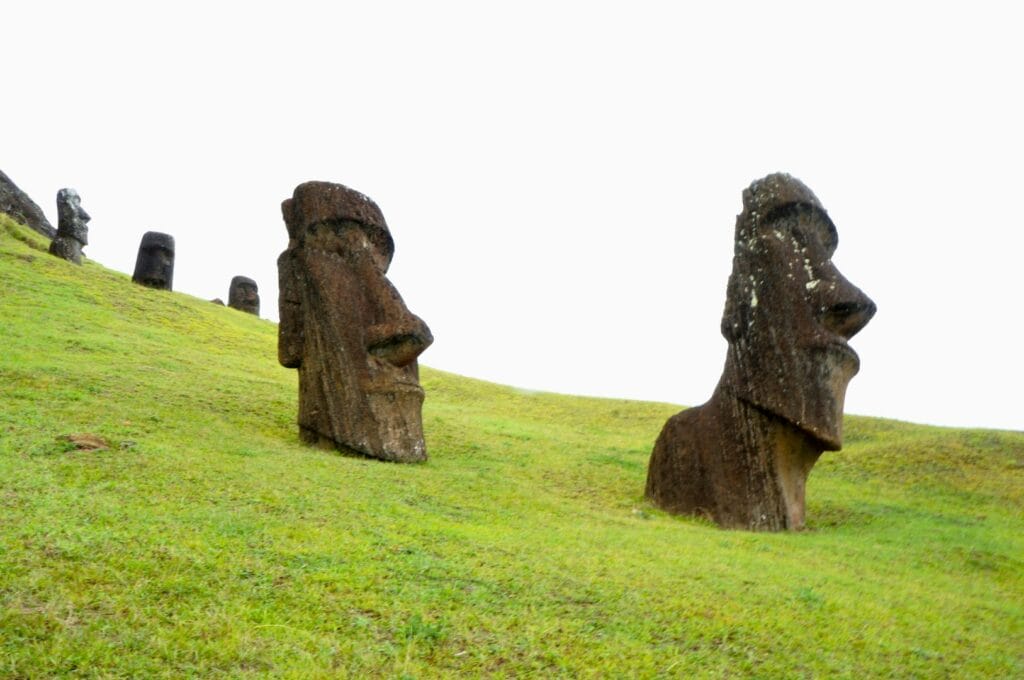
Introduction to Easter Island
Easter Island, or Rapa Nui, is a small piece of land 25 km long and 12 km wide, lost in the middle of the Pacific Ocean in Polynesia, and it belongs to the Valparaíso region of Chile. Imagine this: there’s absolutely nothing within a 2,500 km radius! It’s not for nothing that it’s also called Rapa Nui, which means “the distant one” in Polynesian. Note: there’s only a 2-hour time difference between the island and the South American continent.
Easter Island strongly emphasizes site protection, with nearly half of its surface area being part of Rapa Nui National Park, a UNESCO World Heritage site. This park includes the vast majority of the famous statues 🗿, moai, found on the island.
A closer look at the Moai on Rapa Nui
History of the Moai
You probably know Easter Island for its famous moai, right? But where there are megaliths, there were also inhabitants… It turns out that the first people to set foot on this lost island probably arrived by canoe, powered by their own strength, around the year 1000 AD. Knowing that there’s nothing within 2,500 km, that’s pretty impressive, don’t you think?
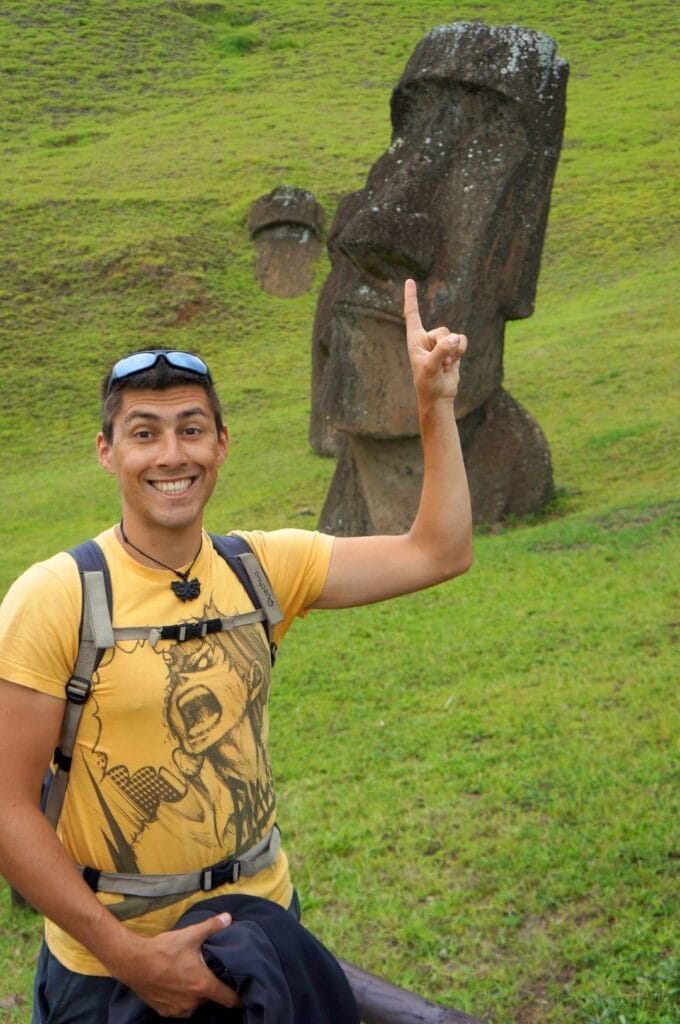
They then began sculpting giant statues now known as the moai, symbols of strength and protection! A fierce competition ensued among the tribes to have the largest moai, as the tribe with the biggest one naturally dominated the others! Can you believe that the largest moai is about 10 meters tall and weighs 80 tons? The inhabitants of Easter Island were indeed skilled!
Note: You’ll notice that many sites start with the term Ahu, which refers to the platform on which the moai is erected.
The Birdman cult
Well, after a few hundred years, coupled with some famines or other diseases, the inhabitants began to realize that these moai weren’t really useful after all. This led to the emergence of the Birdman cult (Tangata Manu). Each year, a competition was held between the island’s tribes to crown the famous Birdman. The champions of each tribe had to swim to the Motu Nui islet to retrieve bird eggs (from the sooty tern), then return and climb the island’s most impressive cliff.
The first to reach the top naturally won, bringing numerous benefits to their tribe! Having seen the cliff with my own eyes, I can assure you that these champions were no weaklings! However, many of them ended up dying from a fall or being eaten by sharks. Then, in the 19th century, people from the continent arrived, bringing slavery and tuberculosis with them…
If you want more details about Rapa Nui’s history, check out the Wikipedia page.
What’s the best time to visit Easter Island?
Now that you have a taste of what’s in store for you, you need to consider the island’s subtropical climate. Temperatures remain relatively constant throughout the year since Easter Island is situated in the middle of the Pacific Ocean. During the austral summer, from November to April, you’ll enjoy plenty of sunshine with quite humid heat. The rest of the year, corresponding to the austral winter between May and October, the weather is cloudier, the risk of several showers is high, and it’s slightly cooler in July/August. We were there in April, and the weather was perfect!
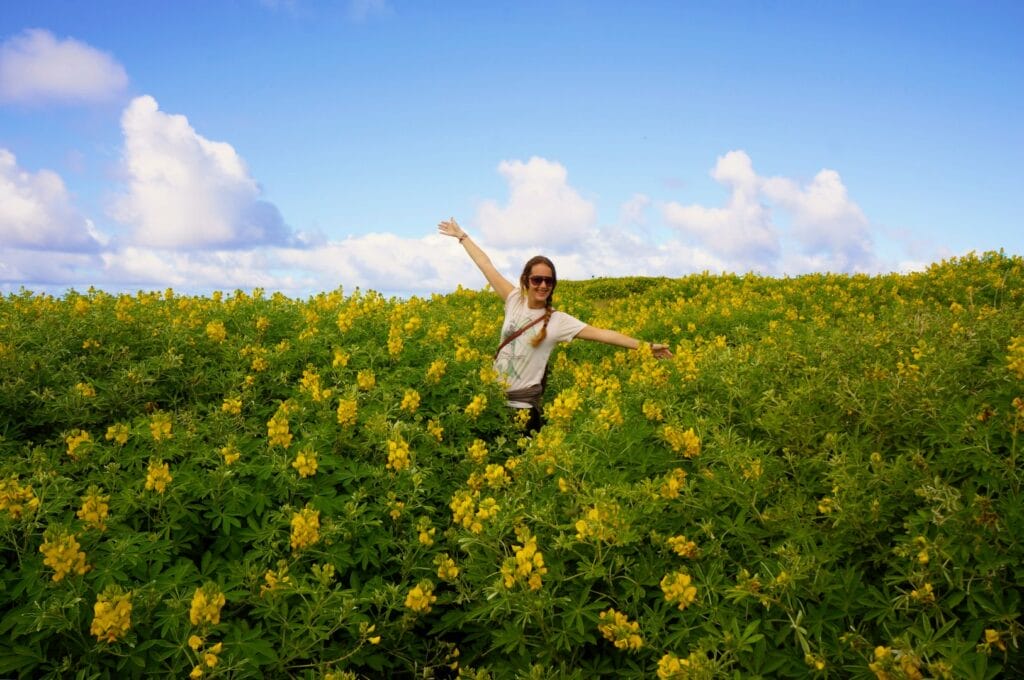
How to get to Easter Island
There aren’t many ways to get to Rapa Nui, as the island is one of the most isolated places in the world! The only options are by plane or boat, with vastly different costs! (Although swimming or rowing there might also be possible, I wouldn’t recommend it.)
Flying to Easter Island
Mataveri International Airport on Easter Island is only LATAM Airlines to two destinations. You can fly from Santiago in Chile (1 or 2 direct flights per day) or Papeete in Tahiti. Either way, the flight takes less than 6 hours. Pay close attention to the arrival time; some flights arrive around midnight, which isn’t ideal if you haven’t booked a hotel. Check all flights here.
Cruising
Understand that cruising to Easter Island isn’t within every budget. For a backpacker budget, organizing such a trip in the middle of a round-the-world journey is challenging.
Another option is to find a private sailboat or use the Chilean Navy, which visits the Chilean island 1-2 times a year. However, the chances of being selected are slim: they prioritize military personnel, their families, and residents before tourists.
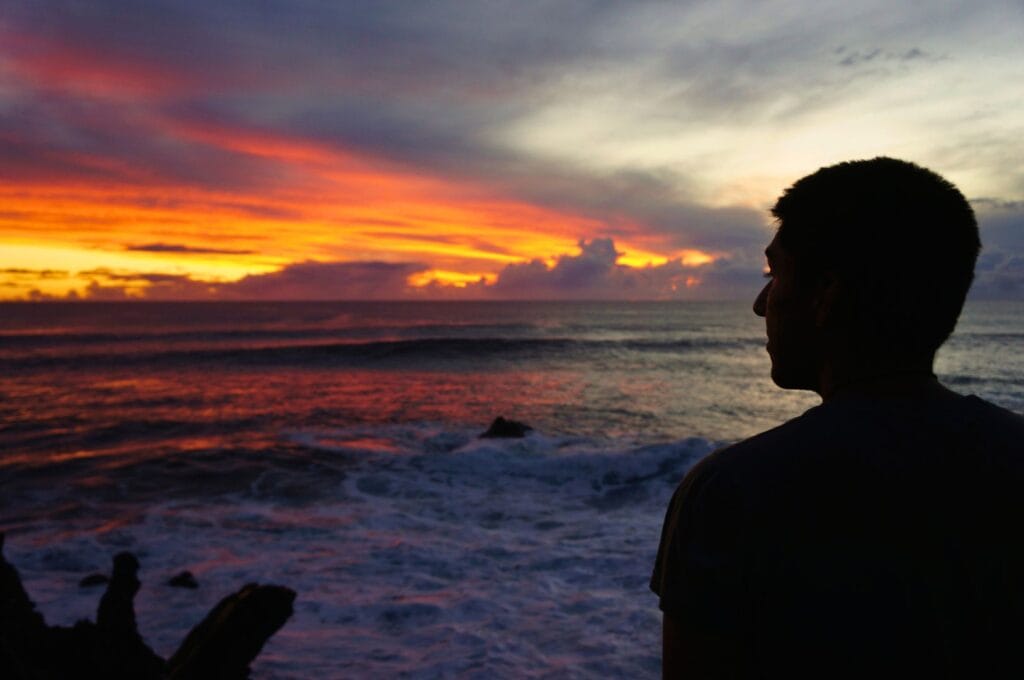
Administrative steps before traveling to Easter Island
Since our trip, many things have changed. Here’s an update so you don’t forget any formalities before leaving.
Visa
To enter Easter Island, the entry requirements are the same as for entering Chile: visa exemption for French, Belgian, Swiss and Canadian citizens for a trip of less than 3 months to Chile, but only 30 days for Easter Island! Indeed, to preserve the island’s cultural and environmental integrity, Chilean authorities have imposed this 30-day limit.
Reservations and entry form to complete
Still, to control the tourist flow, your accommodation reservations and return ticket will be checked. Normally, your accommodation must be listed among those authorized by the tourism services. In theory, all accommodations on Rapa Nui are listed. Also, be sure to fill out this official single entry form within 48 hours before your arrival on the island. This document will be required at the airport; no need to print it.
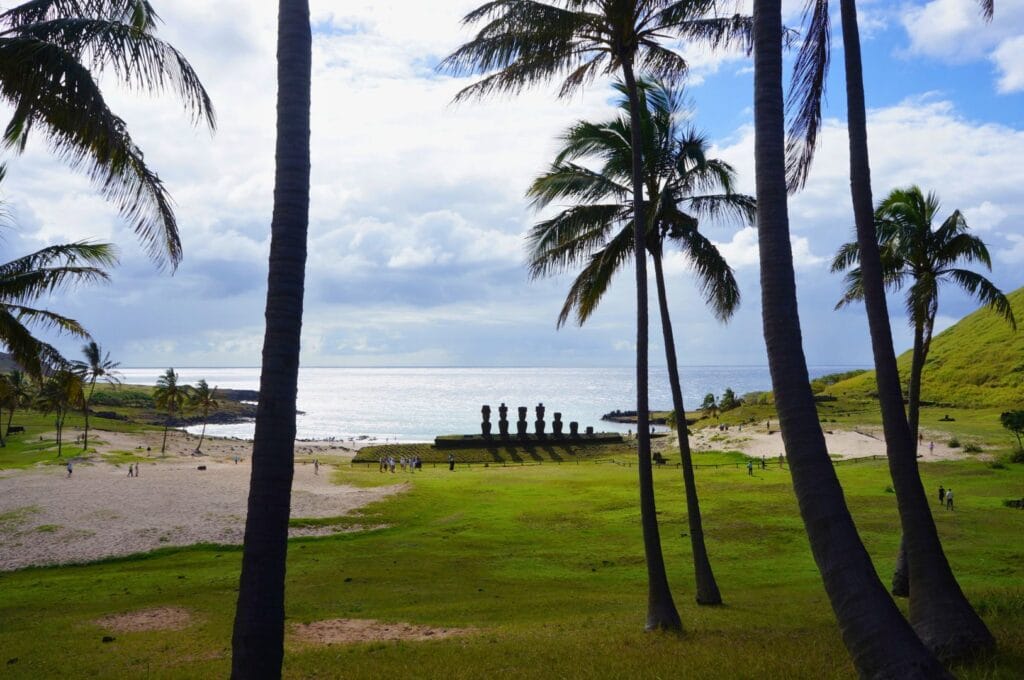
Rapa Nui National Park Ticket
Don’t be surprised if you’re asked to pay $80 per adult upon arrival on the island! This is your entry ticket (boleto) to the Rapa Nui National Park. You must keep this ticket with you at all times for potential inspections. Additionally, each ticket grants you access to the park for 10 days from your entry into the national park. Yes! You’re allowed to stay 30 days on the island, but only 10 days in the park.
Previously, you could buy them directly upon arrival at Mataveri Airport. Nowadays, there are two ways to obtain it: at the official ticket office (address: Kiri Reva s/n in Hanga Roa) or on the official website. Be sure to print it out! For more details on prices, check out our article dedicated to the Easter Island budget.
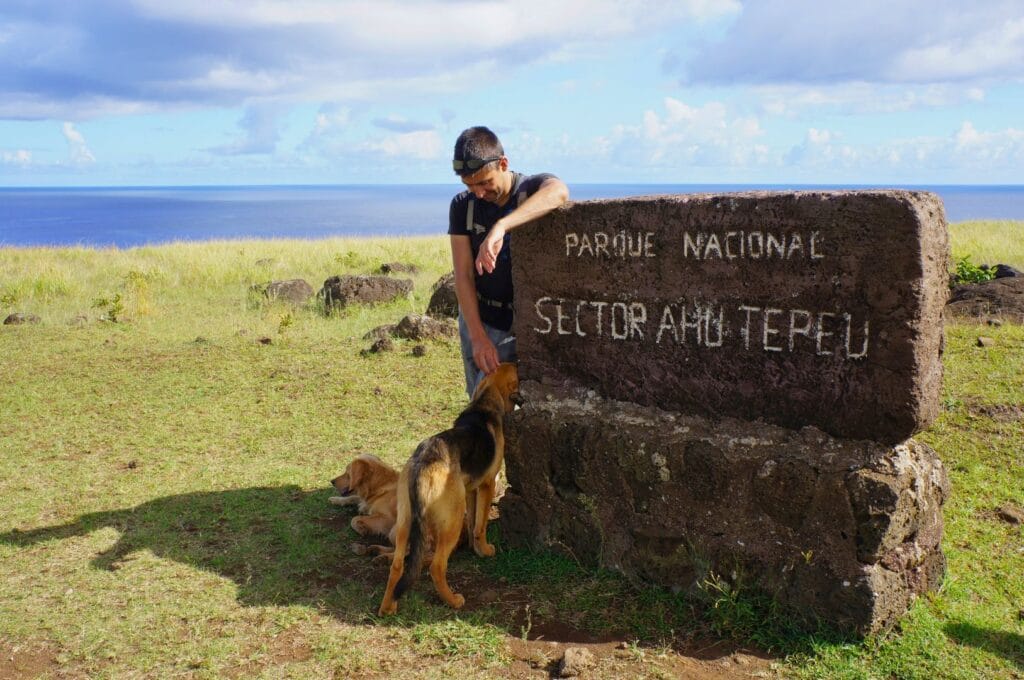
Accommodation on Easter Island
Campgrounds
Let’s be honest, accommodation on Easter Island isn’t cheap. And officially, wild camping is forbidden, so you have no choice but to go to an official campground, even though we’ve seen some rule-breakers!
Today, there are only three campgrounds left on Easter Island, all in the small town of Hanga Roa, as the one on Anakena Beach to the north has closed:
- Minihoa;
- Mohevia;
- Tipanie Moana (which also serves as a hostel).
Finding them is easy because Hanga Roa is the island’s only town, where you’ll find all the hotels, restaurants, banks, and shops.
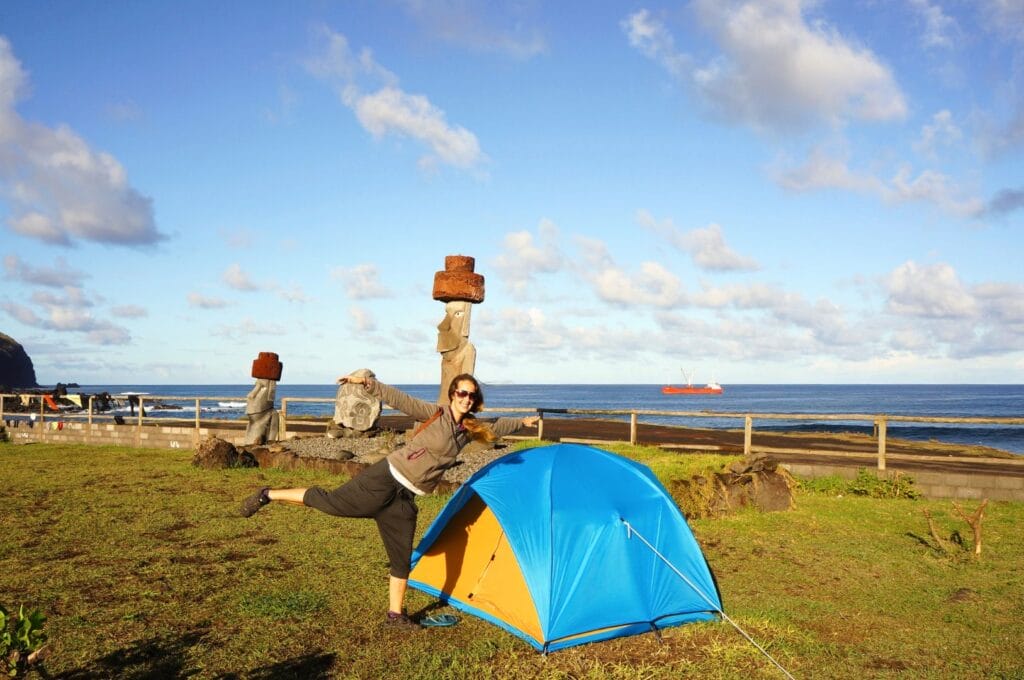
Minihoa Campground
We’ll recommend just one because it was so good: Minihoa Campground. Located by the ocean, it’s the perfect spot to admire the sunset and fall asleep to the sound of the waves. Plus, the campground is well-equipped! With your spot, you get a locker containing dishes for two people. The kitchen is huge and in perfect condition, and the restrooms are spotless. Everything is set for great evenings with other campers and to enjoy amazing sunsets with a cold beer in hand! Additionally, the transfer to and from the airport is included in the price. Honestly, we’ve rarely pitched our tent in such a quality campground, so we highly recommend it!
To reserve a spot at Minihoa Campground, we suggest contacting them directly by email at contacto@mihinoa.com. You can also book a spot on some websites, but the prices are exaggerated! You can find all the information about the budget needed to travel to Easter Island here.
Hotels in Easter Island
Camping not your thing? Then you can check out all the hotels on the island. But be warned, the prices are also quite steep over there ;).
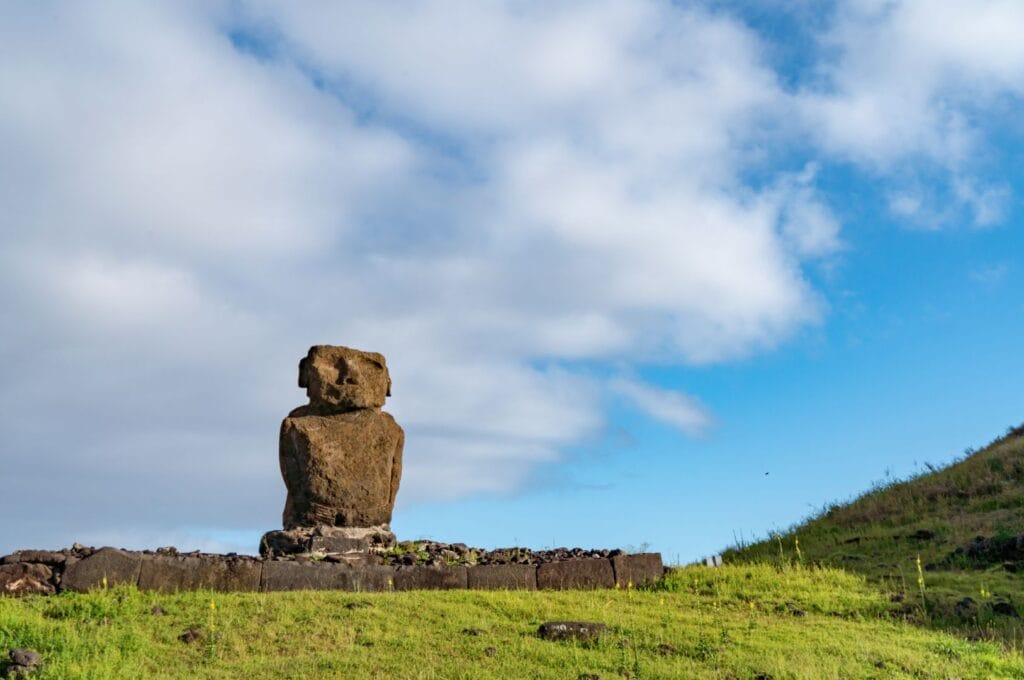
This article contains affiliate links to partner sites. When you use our links to book accommodation, a car, or an activity, you don’t pay anything extra, but we get a small commission. This helps us to offer you free, independent, and ad-free content. Thank you for your support!
Electricity and internet access on Rapa Nui
Back in the day, we had to pay for electricity! Rest assured, those days are over. On the other hand, electrical outlets on Easter Island are of the C and L type, as in the rest of Chile. Our European plugs work well with C plugs, but for L plugs you’ll need an adapter.
As far as wifi is concerned, things have remained as they are. Internet connections on the island are weak or non-existent. This is your chance to disconnect!
Hiring a guide to visit Easter Island
Since the site reopened in 2022 following the pandemic, a guide is now mandatory to visit Rapa Nui and its mysterious megaliths. The Rapa Nui National Park is currently managed by the indigenous Ma’u Henua community. You will need to check for available guides in the town of Hanga Roa or book them online here or here. Of course, the entrance ticket does not include the guided tour, which increases the overall budget.
According to the official park website, you must be accompanied by a guide or a local escort to visit the following 12 sites:
- Ahu Tahai;
- Orongo;
- Ahu Vinapu;
- Hana Te’e Vai Hu;
- Aku Akahanga;
- Rano Raraku;
- Ahu Tongariki;
- Ahu Te Pito Kura;
- Anakena;
- Ahu Akivi;
- Puna Pau;
- Ana Te Pahu.
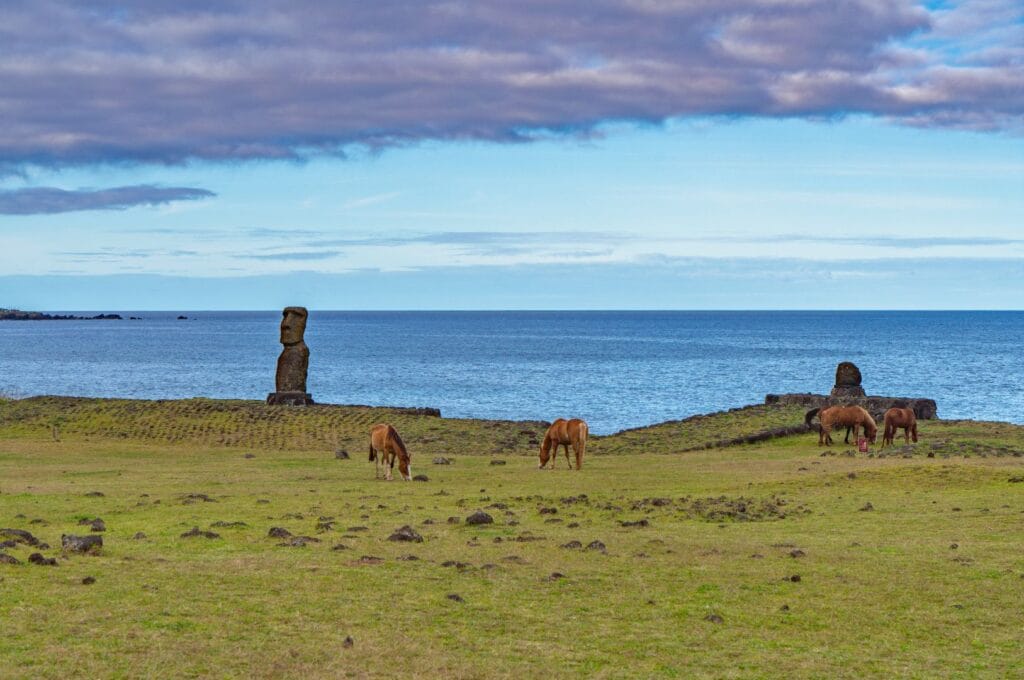
However, only the town of Hanga Roa, Ahu Tahai, and the beaches of Anakena and Ovahe are freely accessible on this list. So for the rest of the island, theoretically, you don’t need a guide. Unfortunately, we don’t have further information on whether a guide is required to watch the sunset from Ahu Tongariki or to hike between Hanga Roa and Anakena. In theory, you can move around freely, without a guide, outside these 12 sites. Please leave us a comment if you have more information!
How to get around Rapa Nui
On foot
Walking is the simplest and cheapest way to get around the island, thanks to its numerous trails! You can easily explore the town of Hanga Roa on foot. For other, more distant sites, we recommend finding or renting a vehicle at least for the return trip. We’ve highlighted in the activities section the best transportation options for each excursion. One detail: we encountered many stray dogs that were super friendly, but we thought it was worth mentioning.
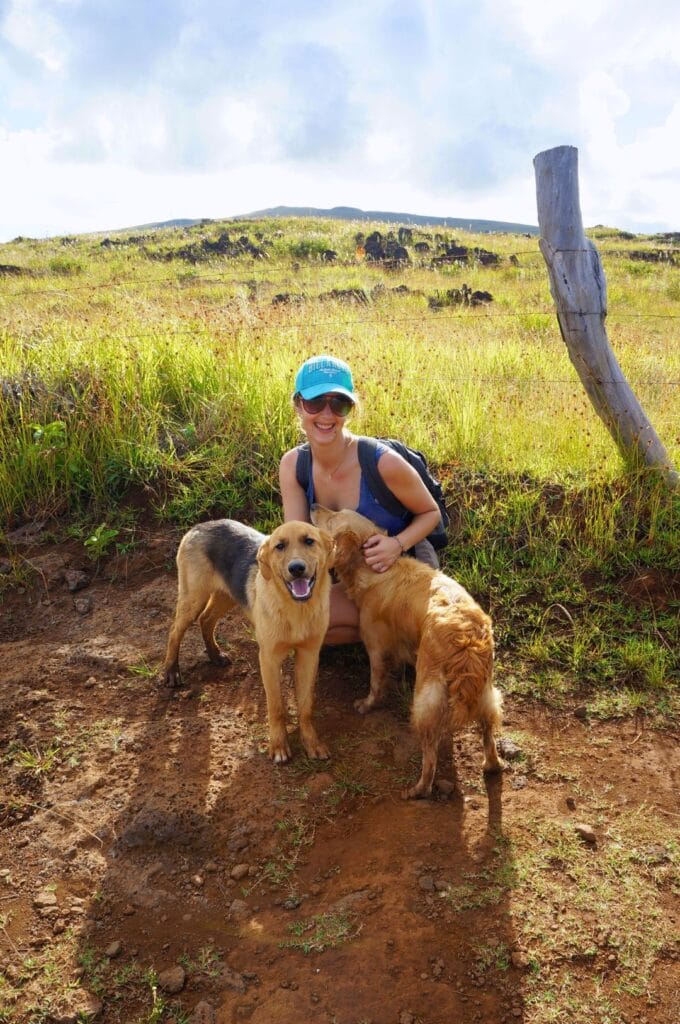
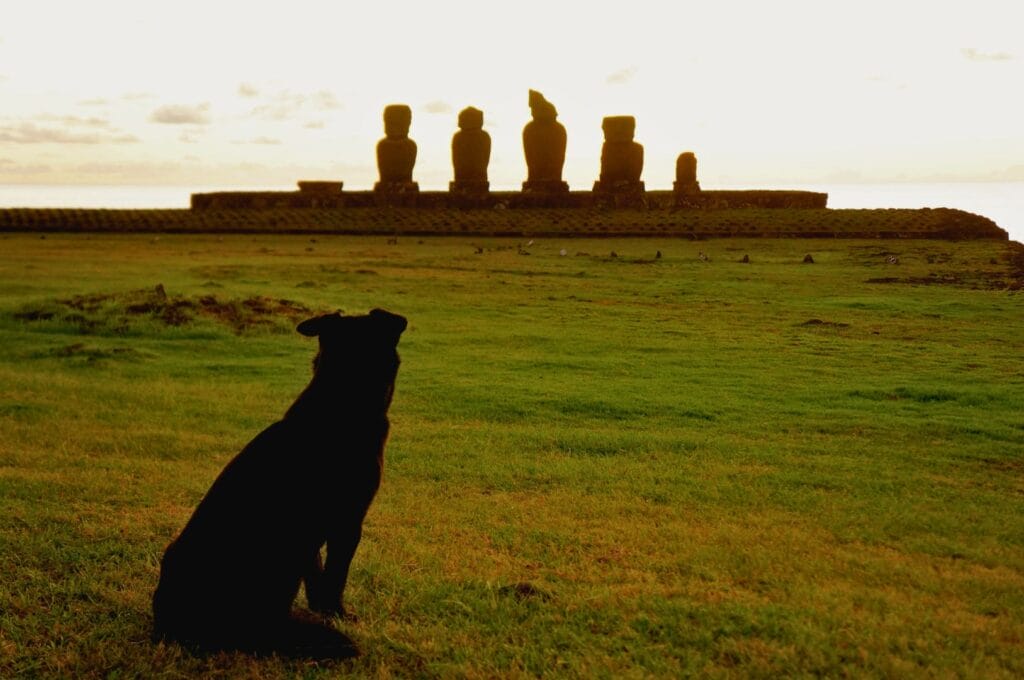
By car
To get around Easter Island, you can rent various types of vehicles, such as 4x4s. Don’t be surprised by the prices—they are quite high compared to most other places in the world. But trust us, it’s well worth it, at least to tour the island! For more details, we’ve broken down the prices on Rapa Nui. A tip is to find other travelers to share the rental costs. Otherwise, hitchhiking is another good way to get around; it’s cheaper! You’ll also find taxis, but as you might imagine, the fare is high.
Note: The rental vehicles are not insured. In case of an accident, you’ll have to cover all the costs based on the damage incurred. To avoid this, choose good travel insurance.
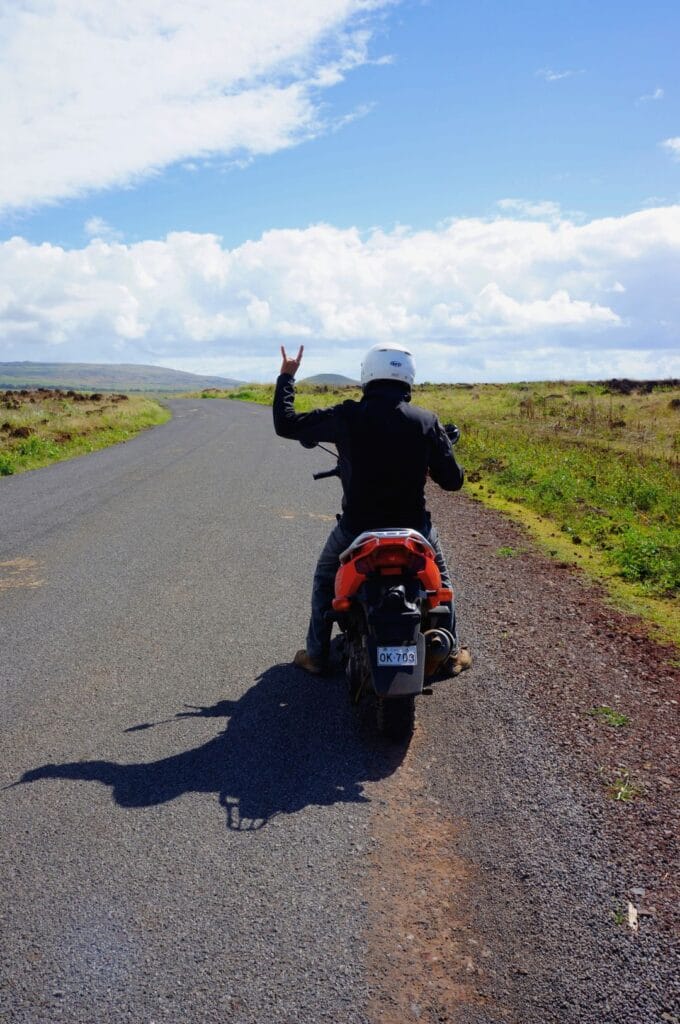
By scooter or quad
For fans of two- or four-wheeled vehicles, you can also rent a scooter or quad to discover Easter Island in its entirety. Note: for scooters, it is essential to have an international driver’s license, and it must include the A category for renting. A standard driver’s license alone is not sufficient.
On horseback
Interested in horseback riding? Several horseback tours are available to experience the island differently. You’ll see many horses roaming freely as you explore the island.
By bike
Along with walking, biking is the most physically demanding and one of the cheapest ways to explore Easter Island. You’ll easily find standard or electric bikes for rent in Hanga Roa.
Things to do on Easter Island
There’s plenty to do on Easter Island: hikes, moai, lava tubes, volcanoes, beaches, and diving! To give you an idea, here’s a personal map of the island.
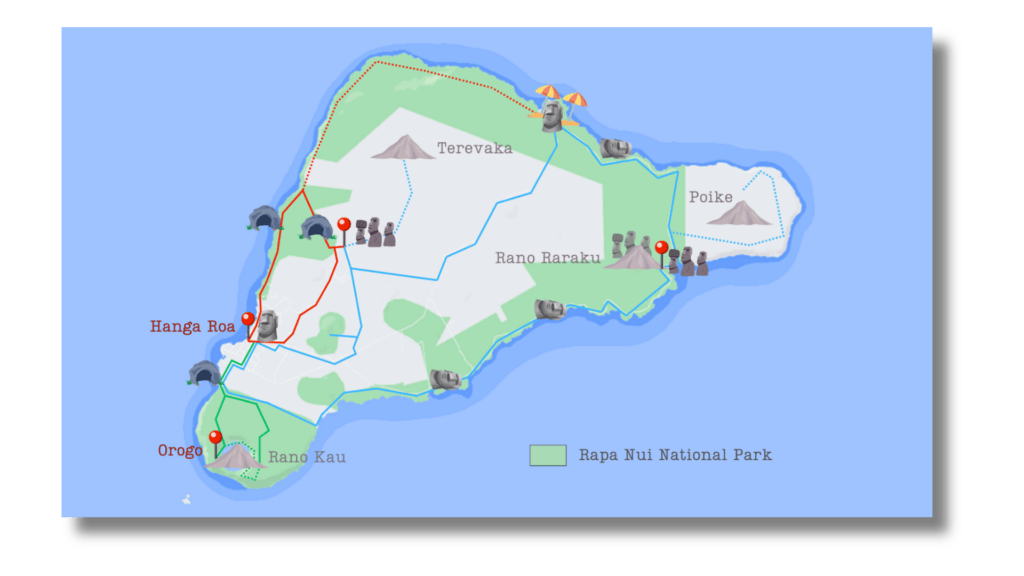
Wander around the town of Hanga Roa
The only town on Easter Island, Hanga Roa has plenty to offer, and exploring it on foot takes about half a day. Here’s our selection of points of interest:
- Sernatur tourist office for additional information and a free moai stamp in your passport;
- the port (you might even see some turtles!);
- the Santa Cruz church;
- the Hanga Kioe lookout;
- the artisan markets;
- the free Pea pool;
- the Poko Poko beach;
- the Ana Kai Tangata cave, which was the most accessible cave on the island with its wall paintings. However, due to the risk of collapse, it is no longer accessible. You can still walk to the cliff edge to enjoy the view.
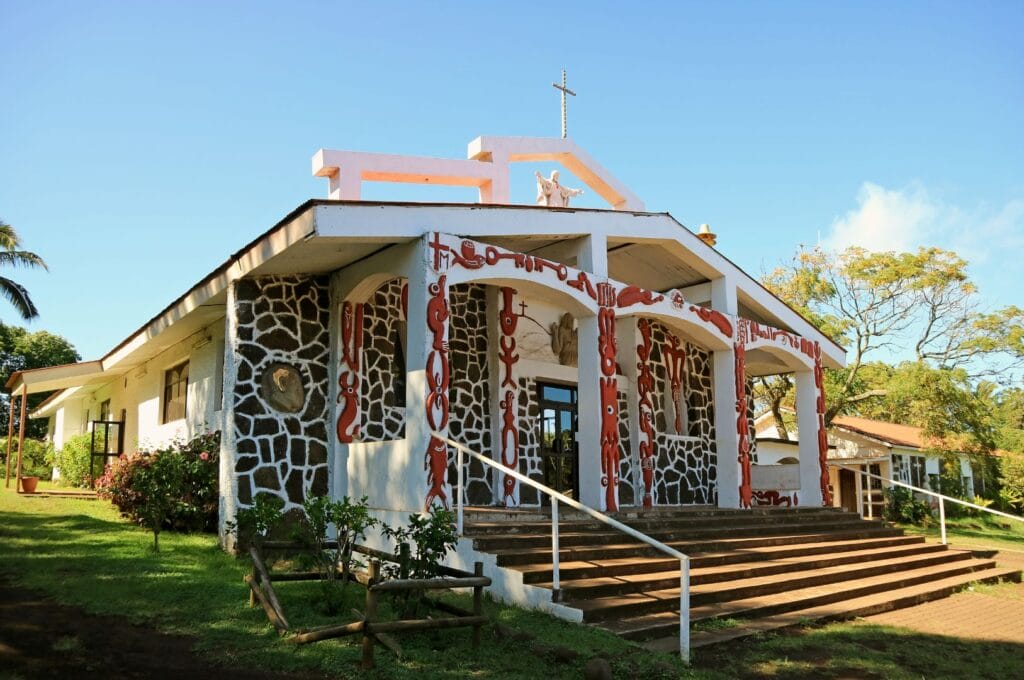
Admire the sunset at Ahu Tahai
North of Hanga Roa, Ahu Tahai is undoubtedly the best spot on Easter Island to watch the sunset behind the large moai statues. One of the statues is also the only one with painted eyes!
Wake up early to see the sunrise at Ahu Tongariki
After the glowing twilight, set your alarm to catch the breathtaking sunrise from Ahu Tongariki. The dawn rises behind the largest row of moai on Easter Island, offering a truly stunning spectacle! Note: to get there, you’ll need transportation.
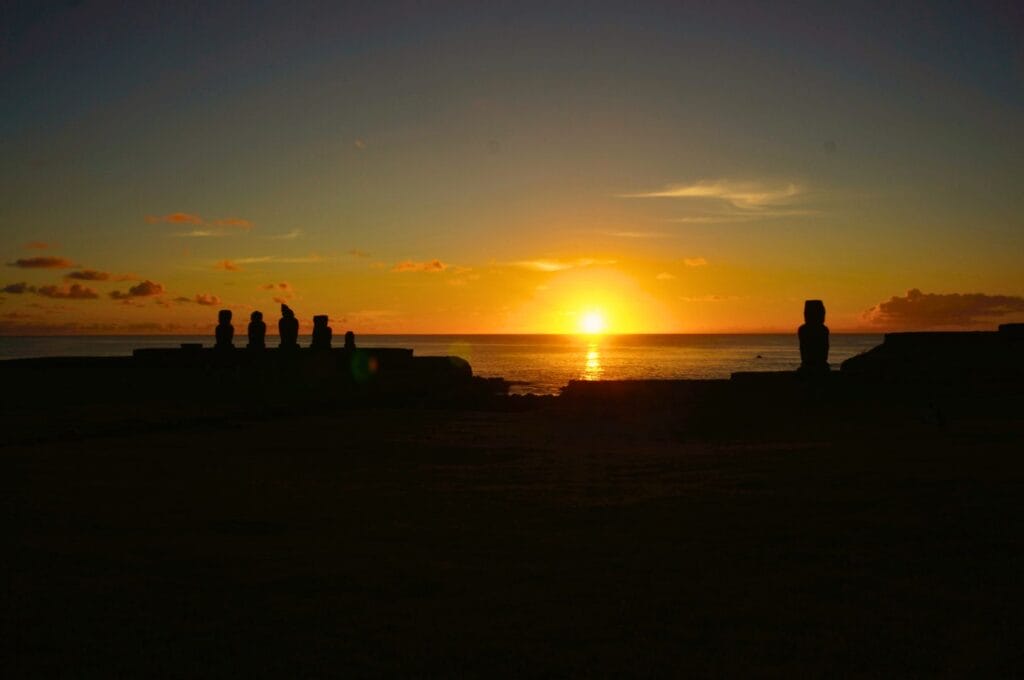
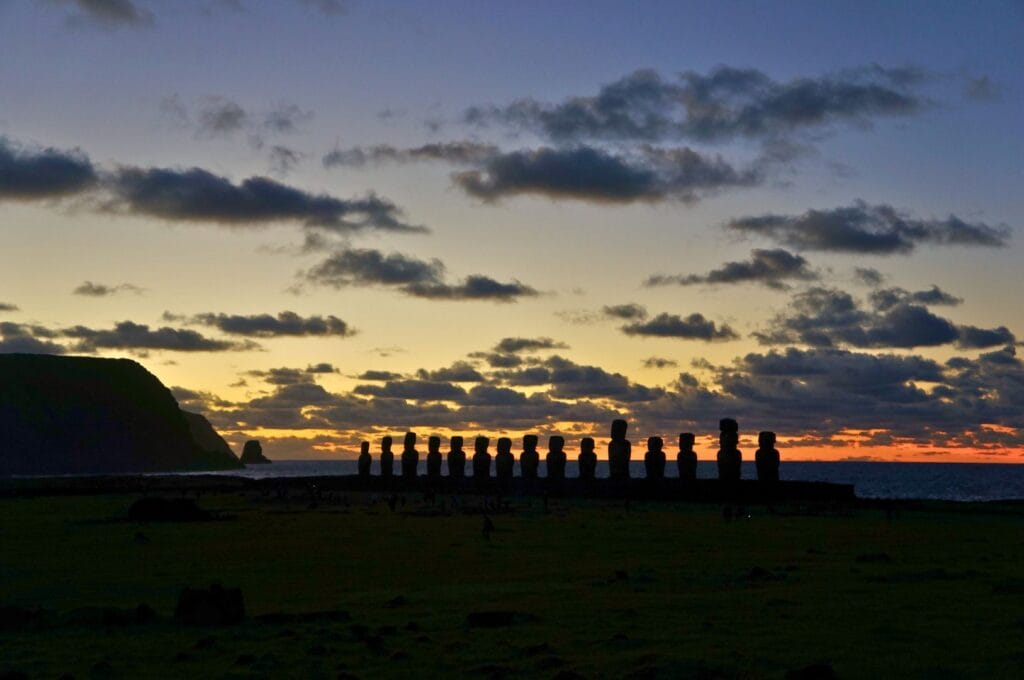
Visit the Orongo Village and climb the Rano Kau volcano
The green trail on the south side of the map leads you to the top of the extinct Rano Kau volcano and the Orongo village, the site of the Tangata Manu, the Birdman competition. Access is easy; a lovely walking path runs along the coast and up the volcano’s slopes.
After marveling at the magnificent 1.5 km wide Rano Kau crater with its breathtaking views of Easter Island and its islets Motu Kao Kao, Motu Iti, and Motu Nui, head to the Orongo village, where a small museum will explain the Birdman ceremony better than I can. You can also visit the archaeological site and get a sense of just how crazy the tribal champions were!
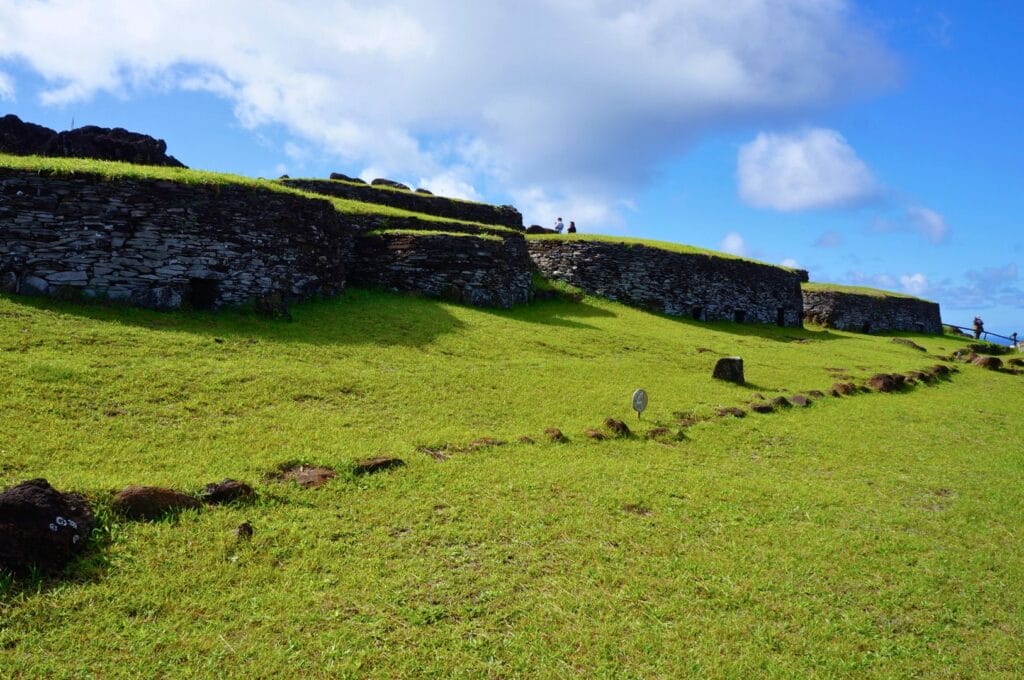
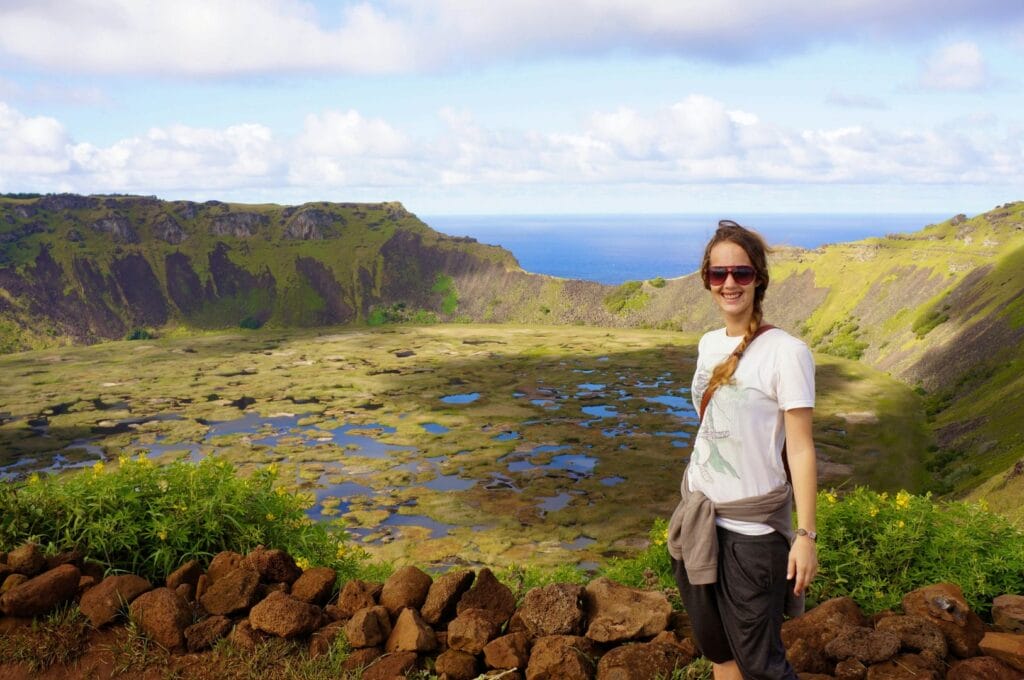
It takes about half a day to cover the 18 km (729 m ascent) from Hanga Roa to the crater, including a visit to Orongo. If you’re lazy, there’s also a road up to the village, but frankly, we’d recommend walking, especially in such an environment.
On this second map, we’ve indicated all the hikes mentioned in this article. You can find the GPS track here.
You can only visit the Orongo archaeological site once with your entrance ticket. Don’t hesitate to spend more time there than at Easter Island’s other highlights!
For a full-day guided tour, we recommend this one, which covers Orongo, Rano Kau and all the surrounding sites.
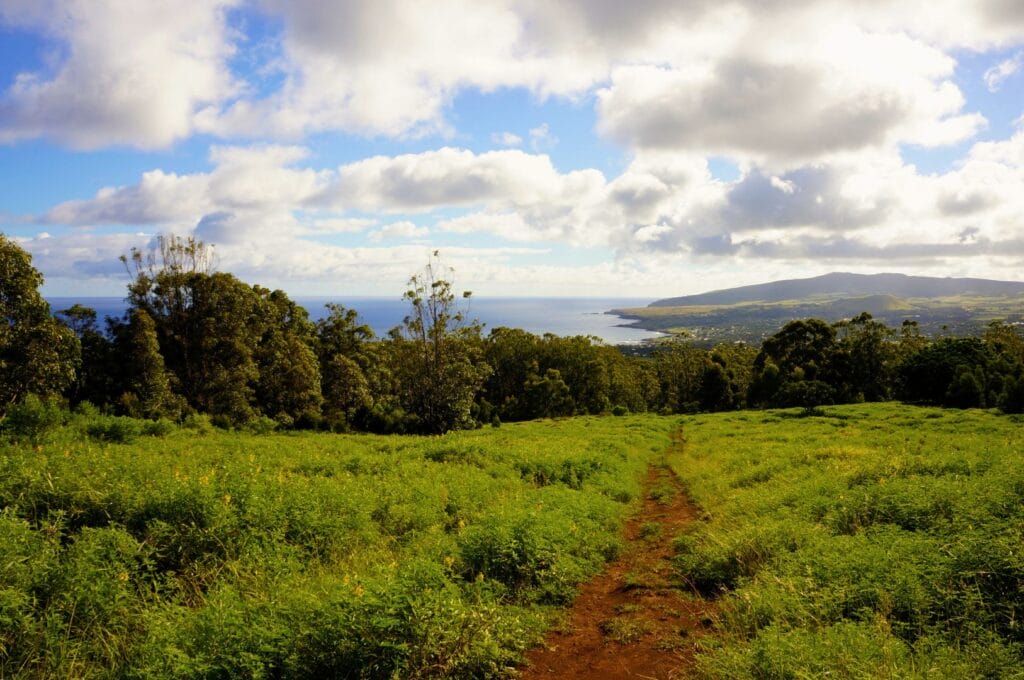
Hiking around Hanga Roa
The red trail on the first map takes you on foot to Ahu Te Peu and brings you back via the moai at Ahu Akivi. This hike will take up most of the day; you’ll cover about 15 kilometers with a 250-meter elevation gain. The entire coastal section to Ahu Te Peu is splendid. You’ll pass the Ana Kakenga lava tube with its two openings to the ocean and nearby others that once served as homes for Easter Island’s inhabitants. And if you’re lucky, you might even see frescoes on the walls of these lava caves.
But the highlight of the hike is the moai at Ahu Akivi! Although we had already seen a few statues along the way, here you’ll find a row of seven moai standing proudly, facing the ocean. Impressive! We had a picnic next to them, and it was quite pleasant. Just before, you can take a short detour to the Ana Te Pahu cave, one of the largest caves on Rapa Nui. However, the return journey to Hanga Roa via the island’s interior is not particularly noteworthy.
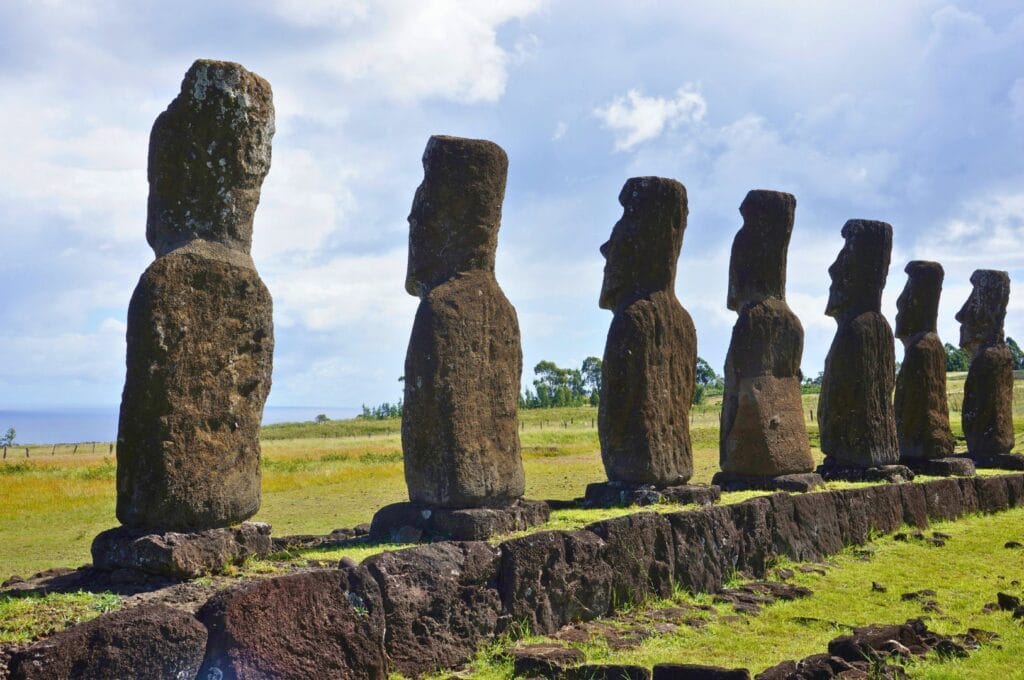
Journey to Anakena
A small regret: if we could redo the hike around Hanga Roa, we would have followed the coast to Anakena, a beautiful white sand beach lined with palm trees located in the north of the island. And while we were at it, we would have gone to Ovahe, a small wild beach with pink sand less than 1 km east of Anakena. We’ve heard from other travelers that the coastal route to Anakena is truly incredible. And you won’t run into many tourists during the walk! We’ve marked this route with dotted lines on the first map and a solid line on the second.
You can walk there and return by car, but doing the round trip entirely on foot is a challenge in itself. You’ll have to walk those 42 km with a 460-meter elevation gain! If you want to walk from Hanga Roa to Anakena/Ovahe, you’ll likely find a taxi since Anakena is one of the most visited places on Easter Island. For a cheaper option, hitchhiking works very well! Since most travelers have rental cars, it’s a chance to make friends and offer them a drink in return in the evening.
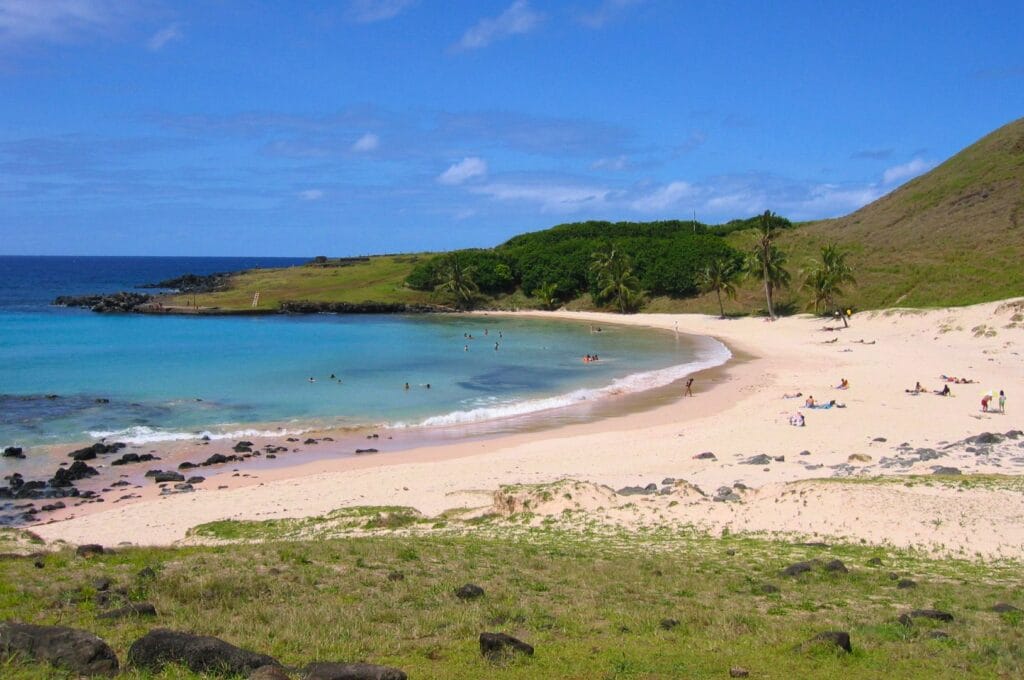
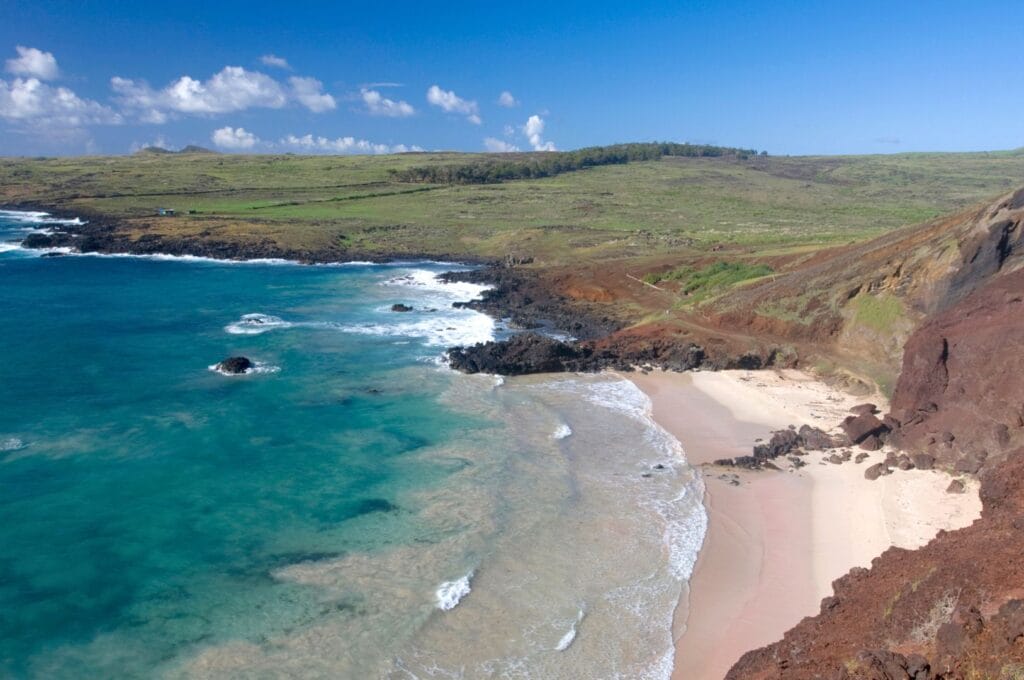
Full tour of the Easter Island
This is the big hike to see all the highlights of Rapa Nui; this route is marked in blue on the Easter Island map. For a guided tour, we recommend this one, which covers the essentials of Easter Island.
The Ahu Vinapu site
Close to the airport, Ahu Vinapu is unlike any other place on Rapa Nui. Here, you’ll find the largest Ahu (platform) on the island, and its precise construction may hint at the still unclear link between the Incas and the island’s indigenous people.
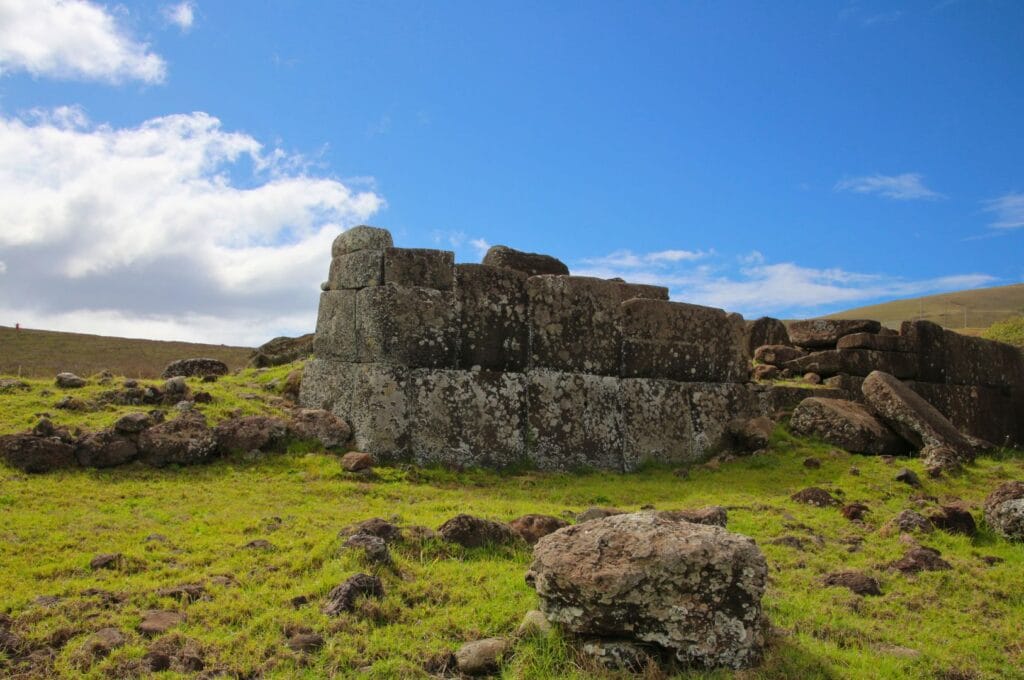
The Eastern coast of Easter Island
The second step: follow the eastern coast of the island. As you can see on the map, there’s a lot to discover! However, don’t expect to see standing moai. Along the coast, most of the stone statues have fallen and are often broken. But this gives the place a particular charm; I personally liked this part of the island!
Rano Raraku volcano
After following the coast, you’ll arrive at the Rano Raraku volcano, a must-see on the island! It was on its slopes, in quarries, that all the moai—about 900—were sculpted. Most of them are still there! It’s not easy to move statues weighing several tons, and it’s still one of the many mysteries surrounding this remarkable island.
This place, also known as the nursery, is just incredible, with moai planted everywhere! Some are still half-carved out of the rock! Honestly, it’s the kind of place that radiates a rather unique energy, hard to describe in words! Don’t miss the Rano Raraku crater, where the lake is partly surrounded by moai heads/busts.
The Rano Raraku quarry can only be visited once with your entrance ticket, so take your time to fully enjoy the site!
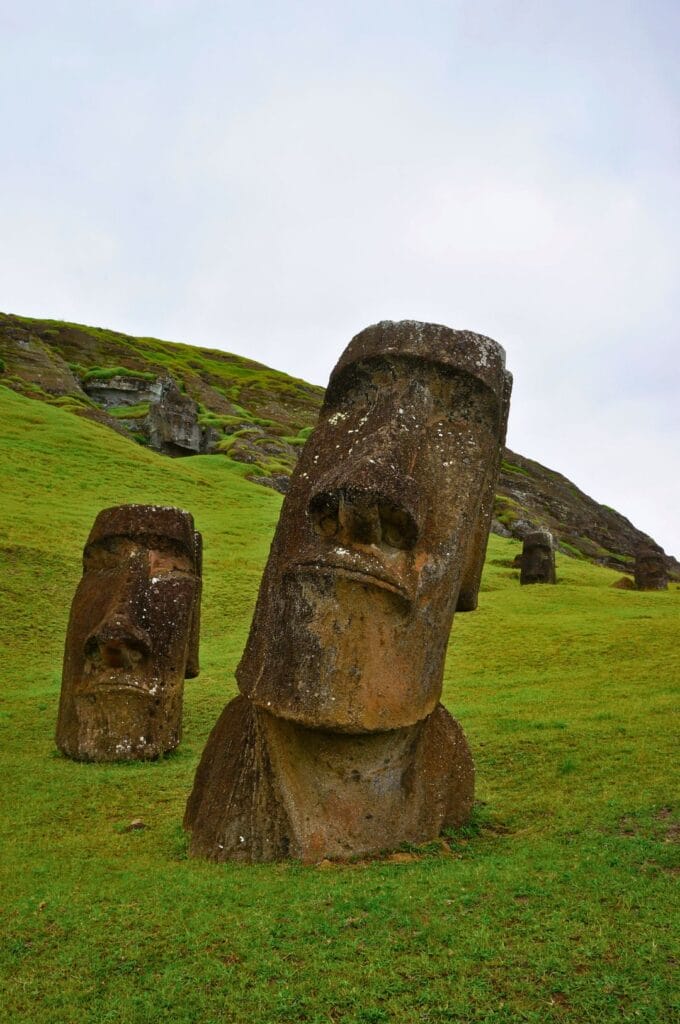
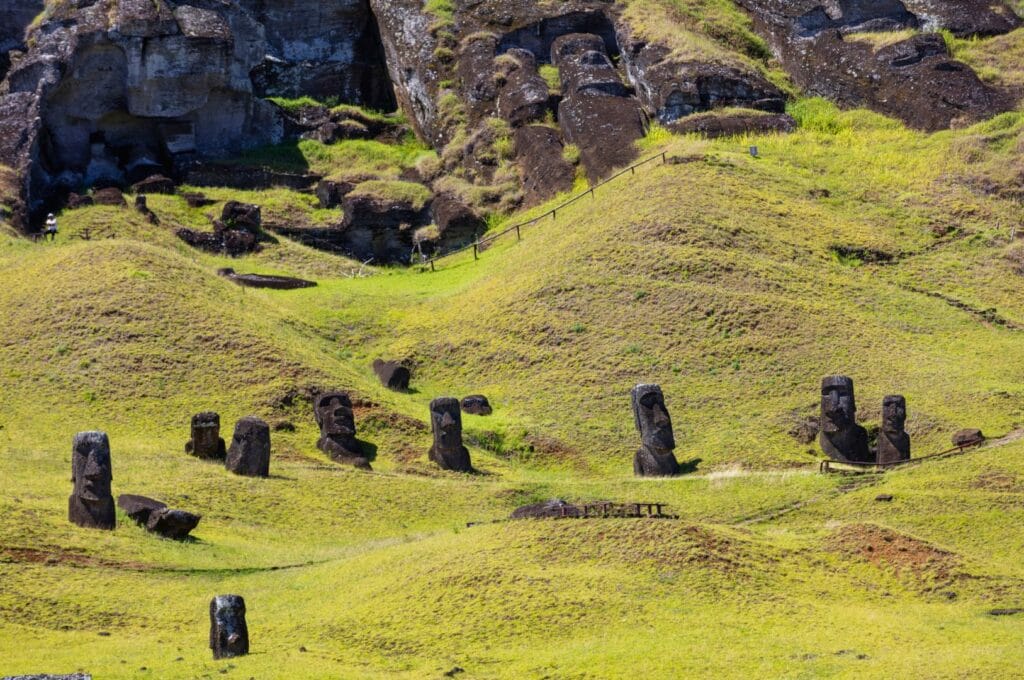
The Ahu Tongariki site
Not far from there is the largest row of moai on Easter Island: Ahu Tongariki. This is probably the place you’ve seen in photos in magazines. 15 moai are lined up, and some statues are nearly 10 meters tall. It’s absolutely incredible! I will return early in the morning to watch the sunrise. Honestly, it’s worth getting up early for ;-).
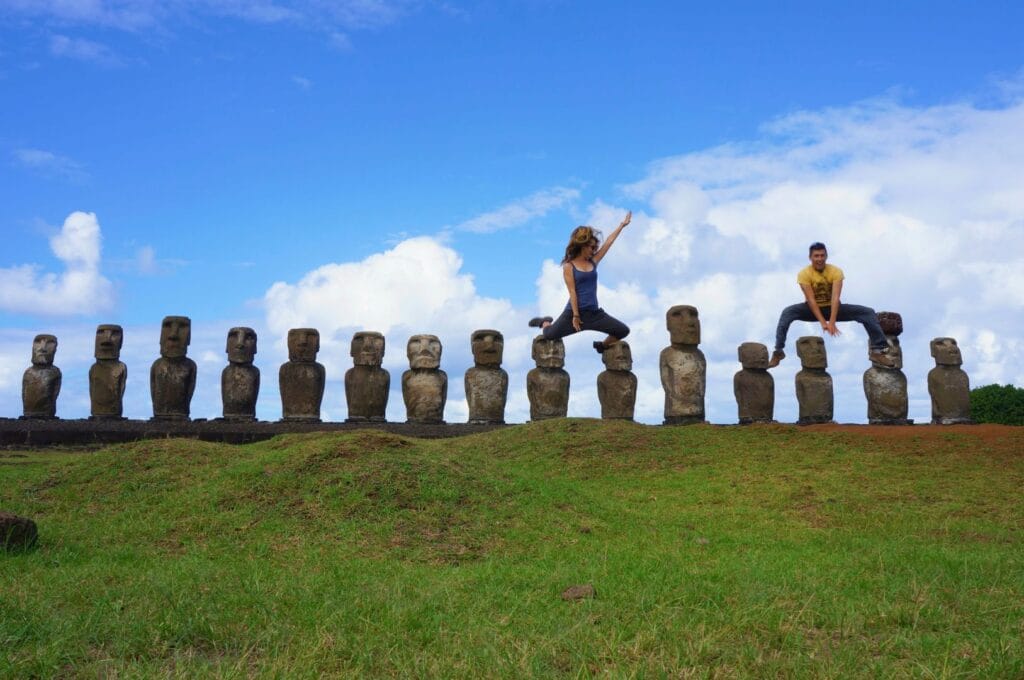
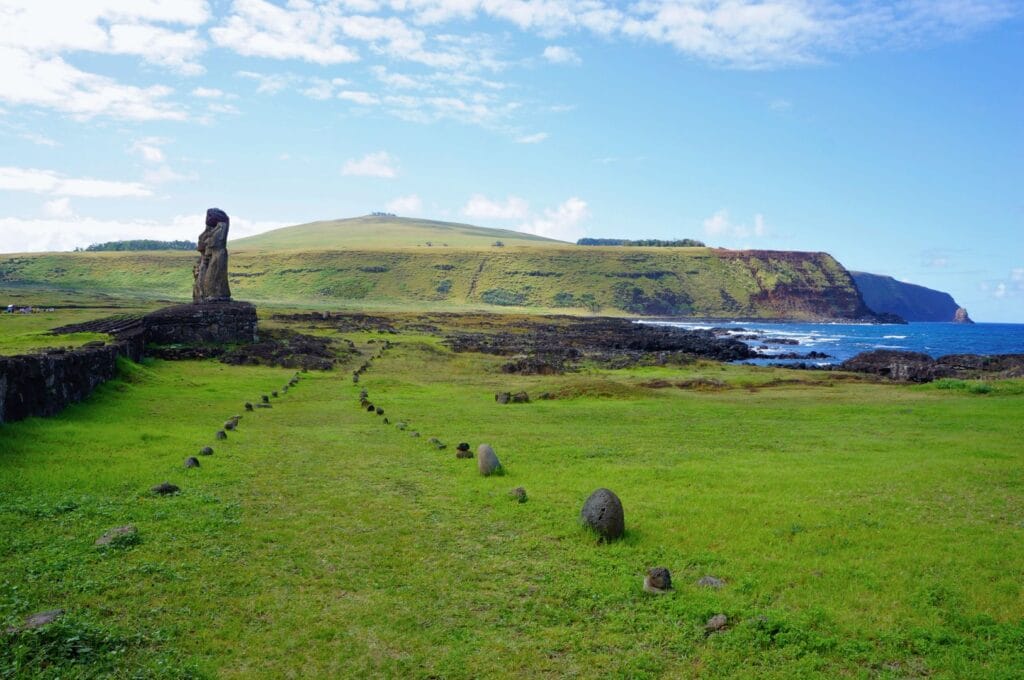
Poike volcano
After Tongariki, the road leads inland, and one thing we didn’t do but could have is the short hike that nearly circles the extinct Poike Volcano. The trail is a 15.4 km round trip with a 286-meter elevation gain. Peaking at 370 meters above sea level, it’s the second-highest point on Easter Island after Terevaka.
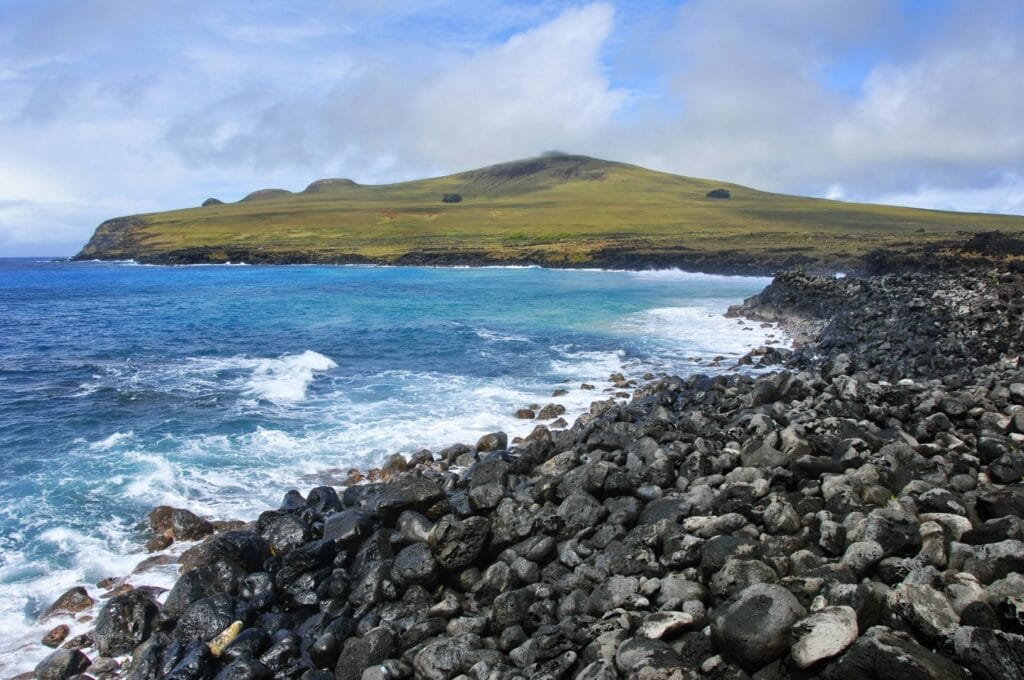
Papa Vaka, Ahu Te Pito Kura and Anakena beach
Next, stop at the Papa Vaka site, where you’ll see numerous petroglyphs, these unique inscriptions carved into the stone. They represent things that surrounded the Rapa Nui people: boats, turtles…
Before enjoying the beach, the last stop is Ahu Te Pito Kura, where the largest moai on the island once stood. Today, you’ll find it lying down, not far from what is considered the navel of the world. You’ll see it represented by a round stone surrounded by four others.
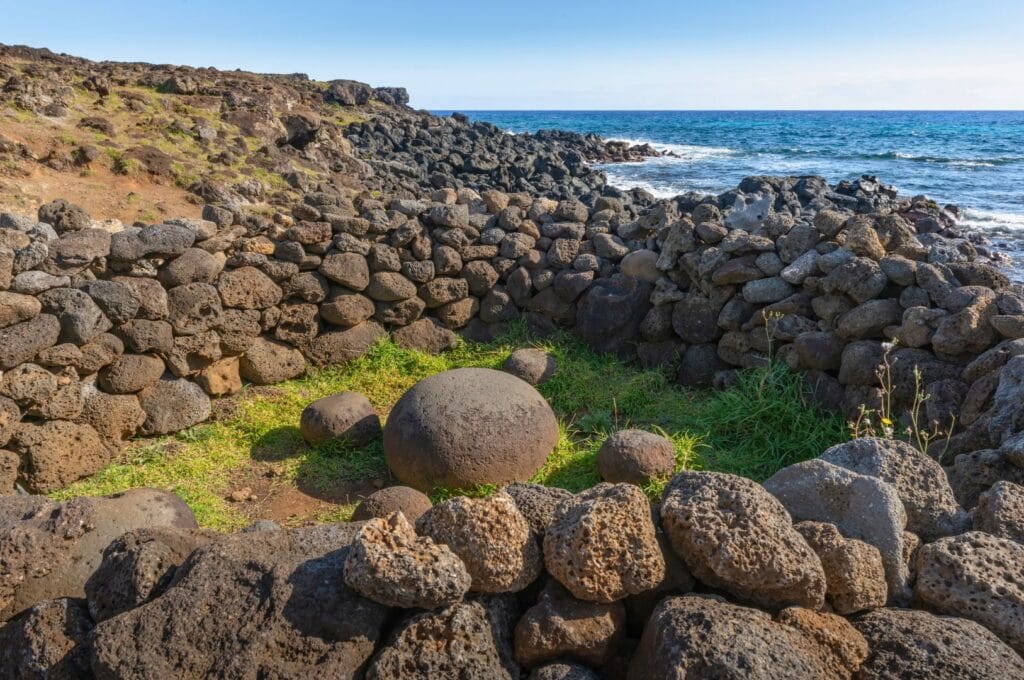
Finally, the last stop of the day is the beautiful Anakena Beach, which I mentioned earlier. You can relax next to a row of 7 moai (Ahu Nau Nau) + 1 lone moai (Ahu Ature Huki) standing guard! Honestly, Easter Island has almost everything to be the dream tourist destination, right?
Ma’unga Terevaka volcano, the highest point on Easter Island
Alright, one more stop we didn’t make is climbing to the summit of the extinct Ma’unga Terevaka volcano, the highest peak on Easter Island. The round trip takes 9.5 km on foot with a 369-meter elevation gain. Here, you’ll be at 506 meters above sea level with a breathtaking panorama of all of Rapa Nui.
Got time? Take advantage of it by walking there, starting from Ahu Akivi. If you’re short on time, some agencies offer bike or horse tours.
Puna Pau or the moai hat factory
It’s at Puna Pau that the moai hats were carved, not at Rano Raraku! Although the site is less impressive than the latter, it can be the last stop on your grand tour of Easter Island.
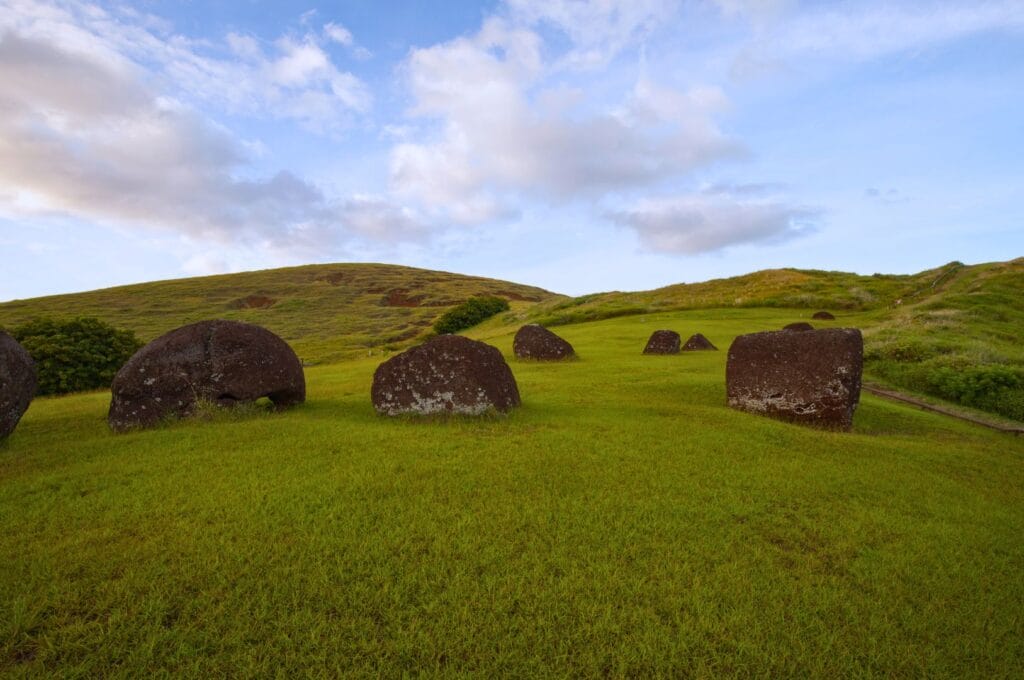
Attend a traditional dance show
We didn’t attend the various traditional dance shows of Rapa Nui, but it could be worth it. The most renowned place is the Kari Kari Ballet, where performances are held on Monday, Wednesday, and Friday with tickets available with or without dinner. Another venue that combines a show with a meal is Te Moana.
Other activities to do on Easter Island
On Easter Island, you can also go snorkeling among coral reefs and marine wildlife, as well as diving. There’s even a popular spot with a moai that was submerged for the movie Rapa Nui.
Alternatively, you can visit in early February during the famous Tapati Festival, where you’ll witness many sporting events and traditional dance performances in costume. However, we can’t say for sure if this festival remains authentic or has become a tourist trap… And keep in mind that prices skyrocket during the festival!
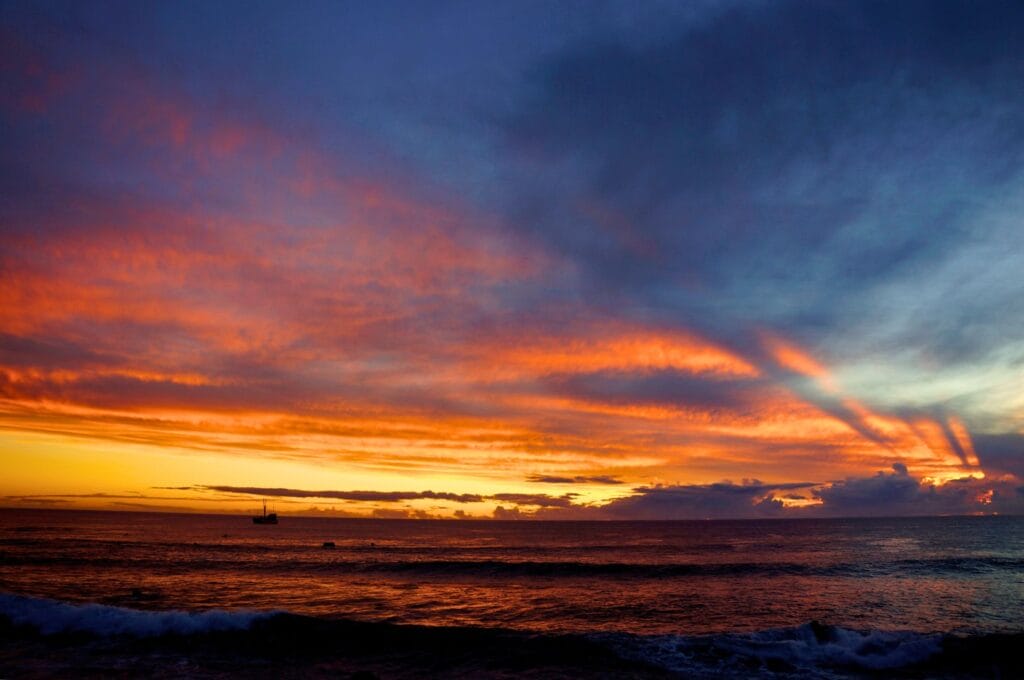
Our opinion on this trip to Rapa Nui
So there you have it, we really enjoyed this week of camping on the remote and mystical Easter Island. It’s one of those places we’ll remember for the rest of our lives, pure moments of happiness! And since we loved it so much, Fabienne prepared an article on how to do Rapa Nui on a budget. We’re spoiling you, aren’t we? As you can tell, we highly recommend this trip to this little piece of land.
So, when are you heading to Easter Island? After this somewhat unique destination, we’re heading back to the continent, off to the fabulous Atacama Desert!
Pin it
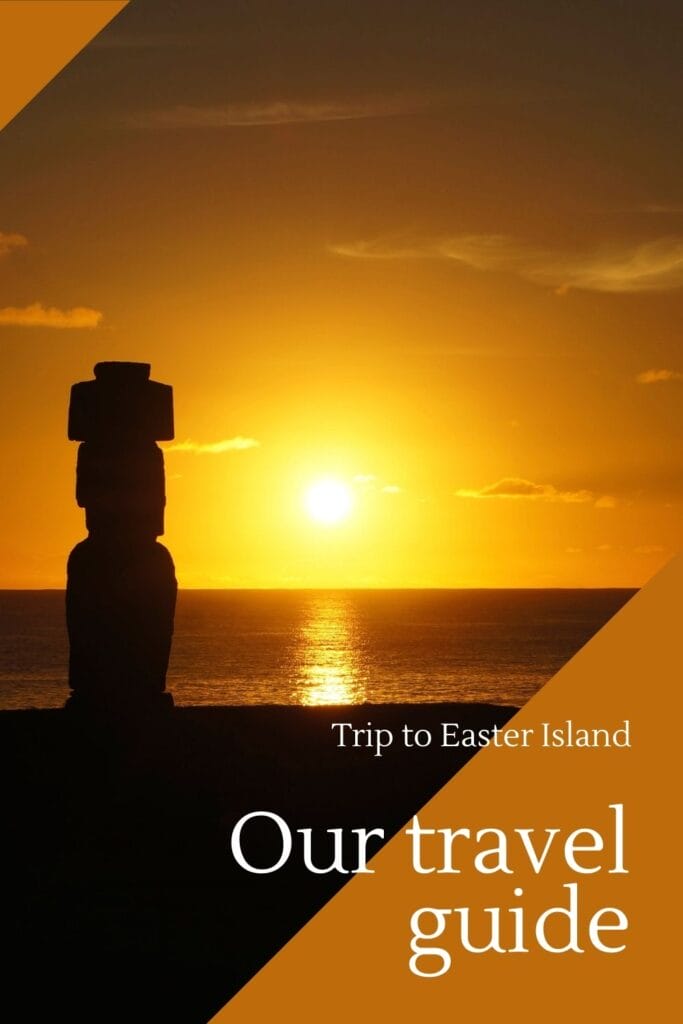
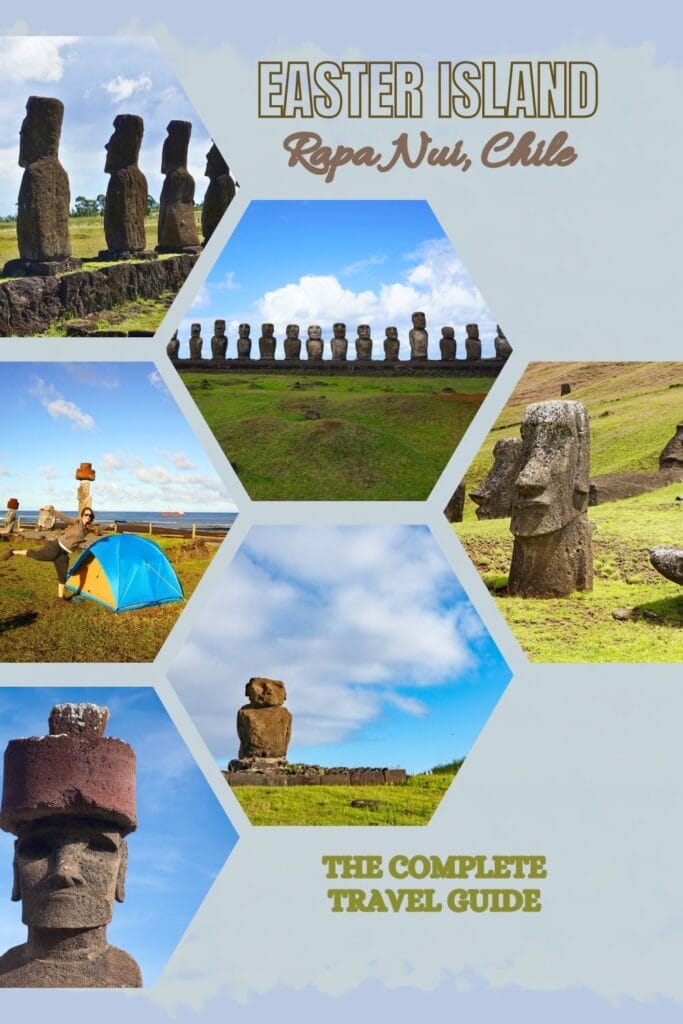
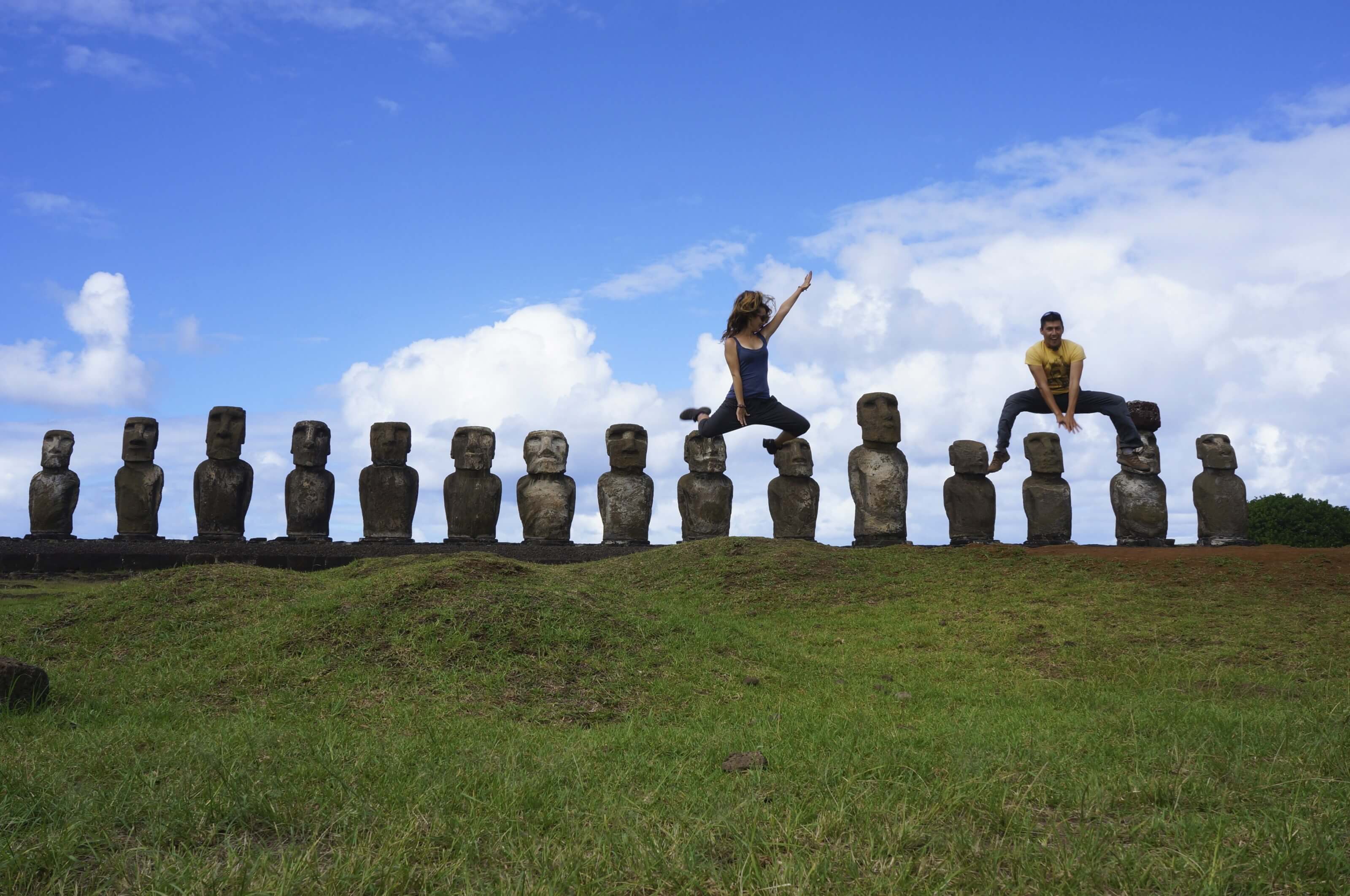
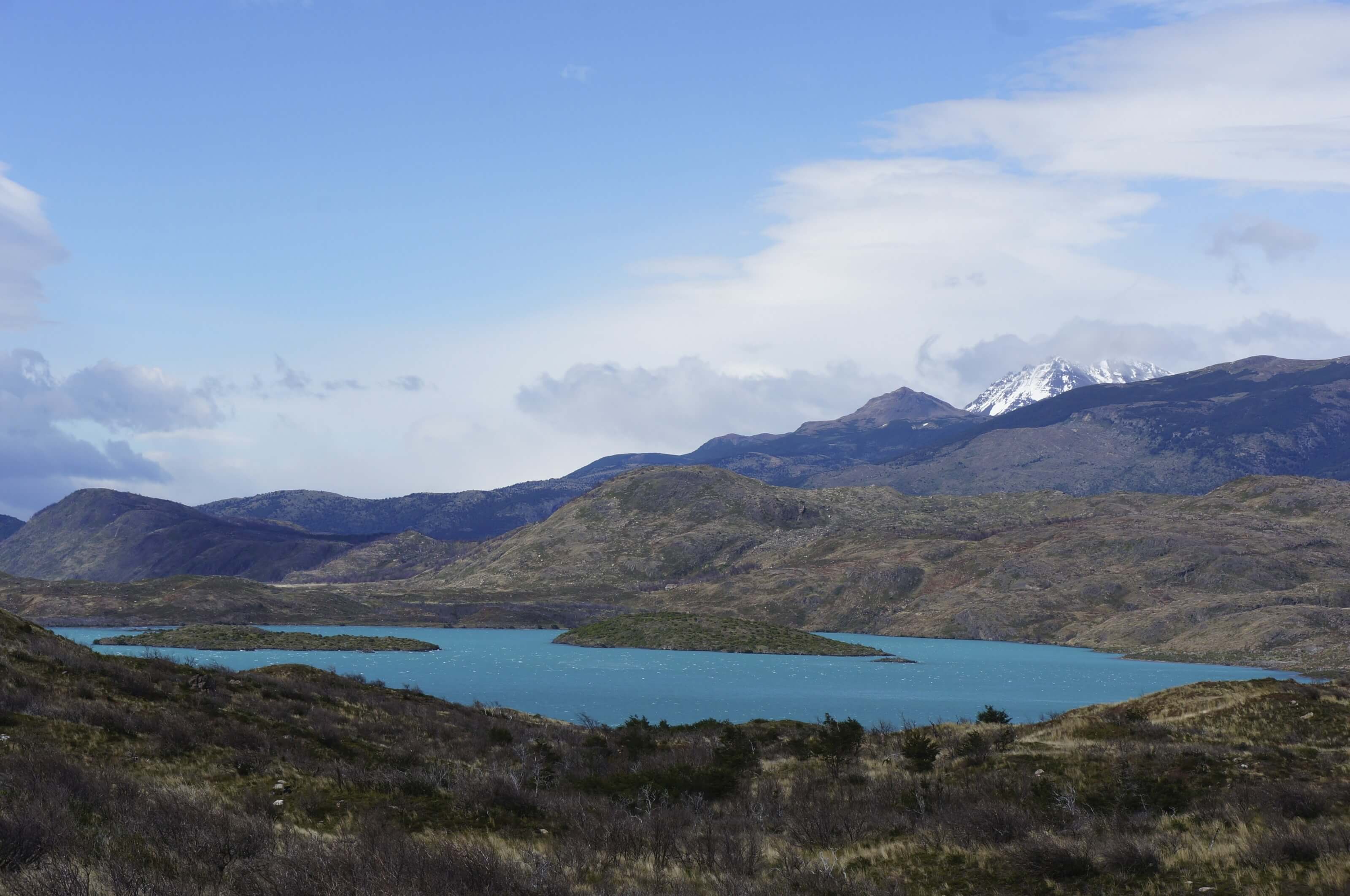
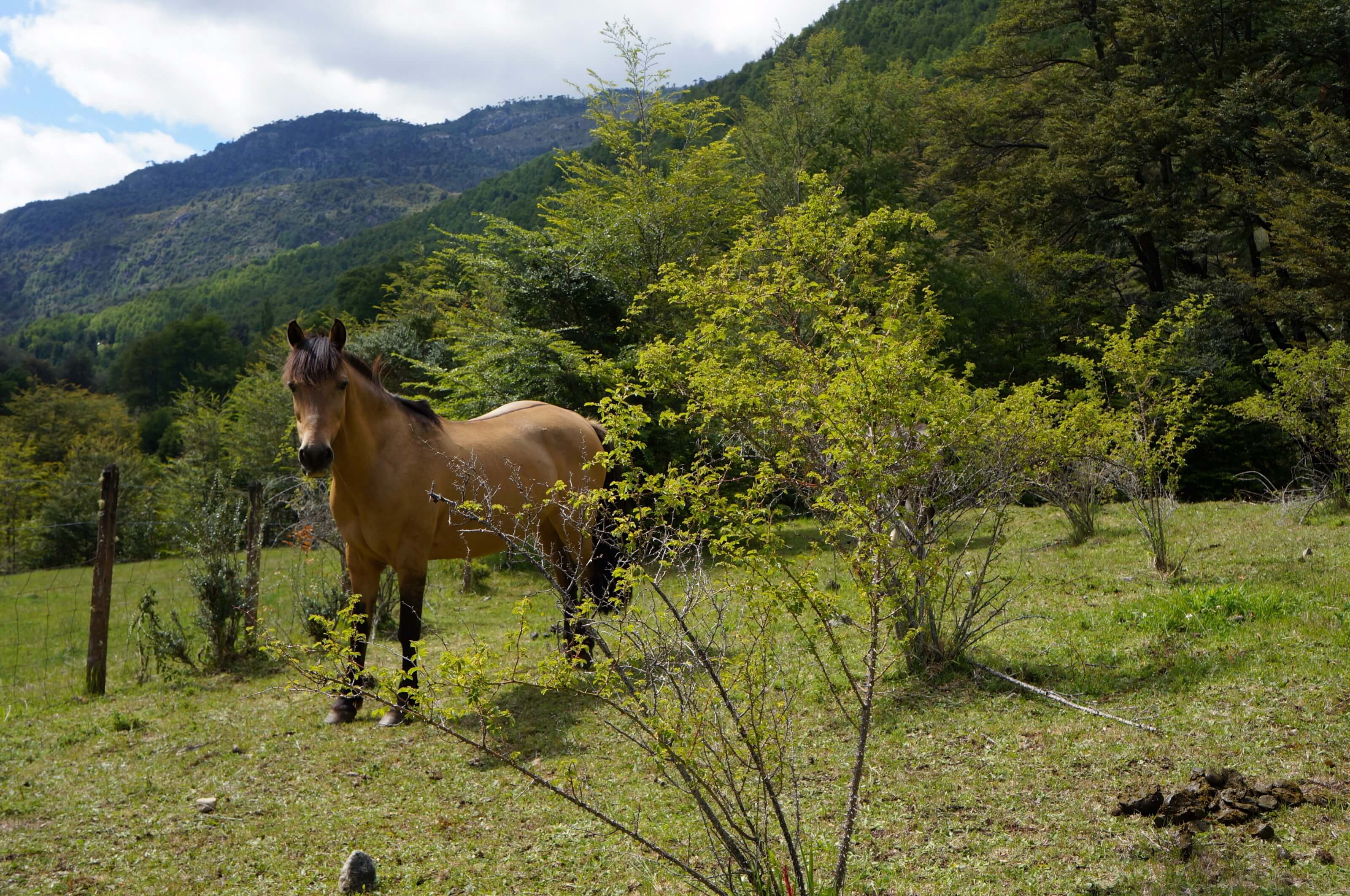
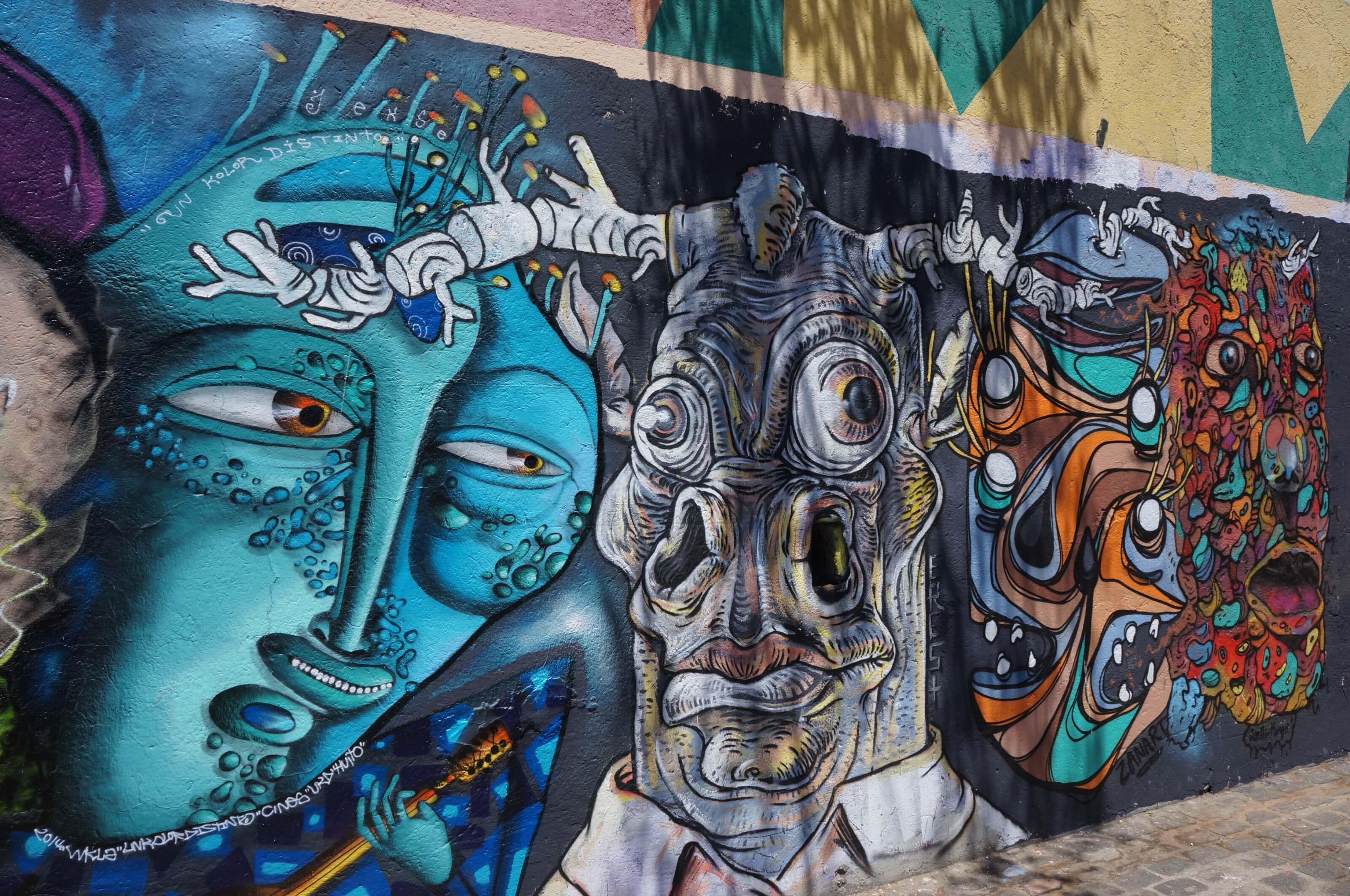
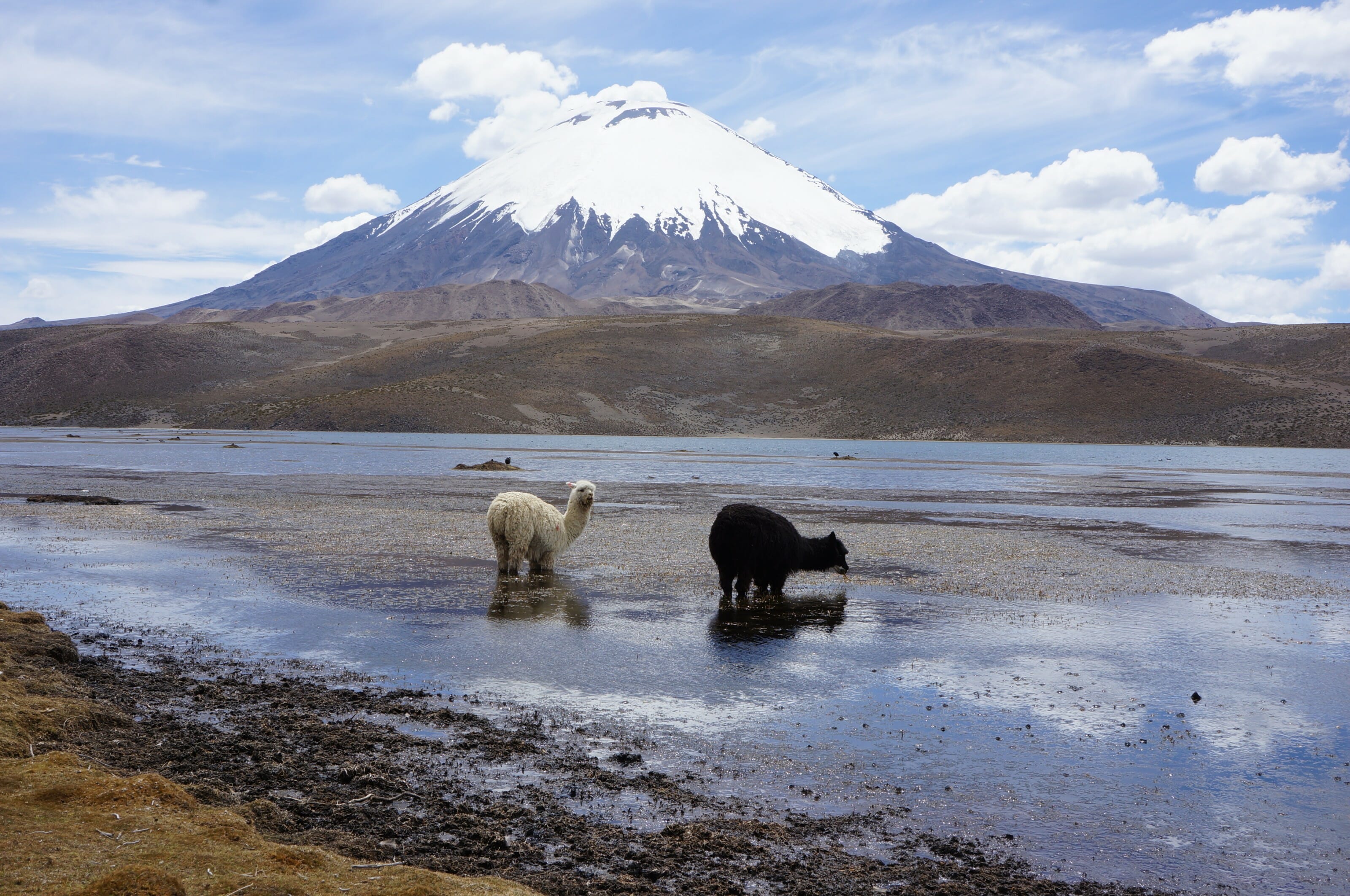
Join the discussion